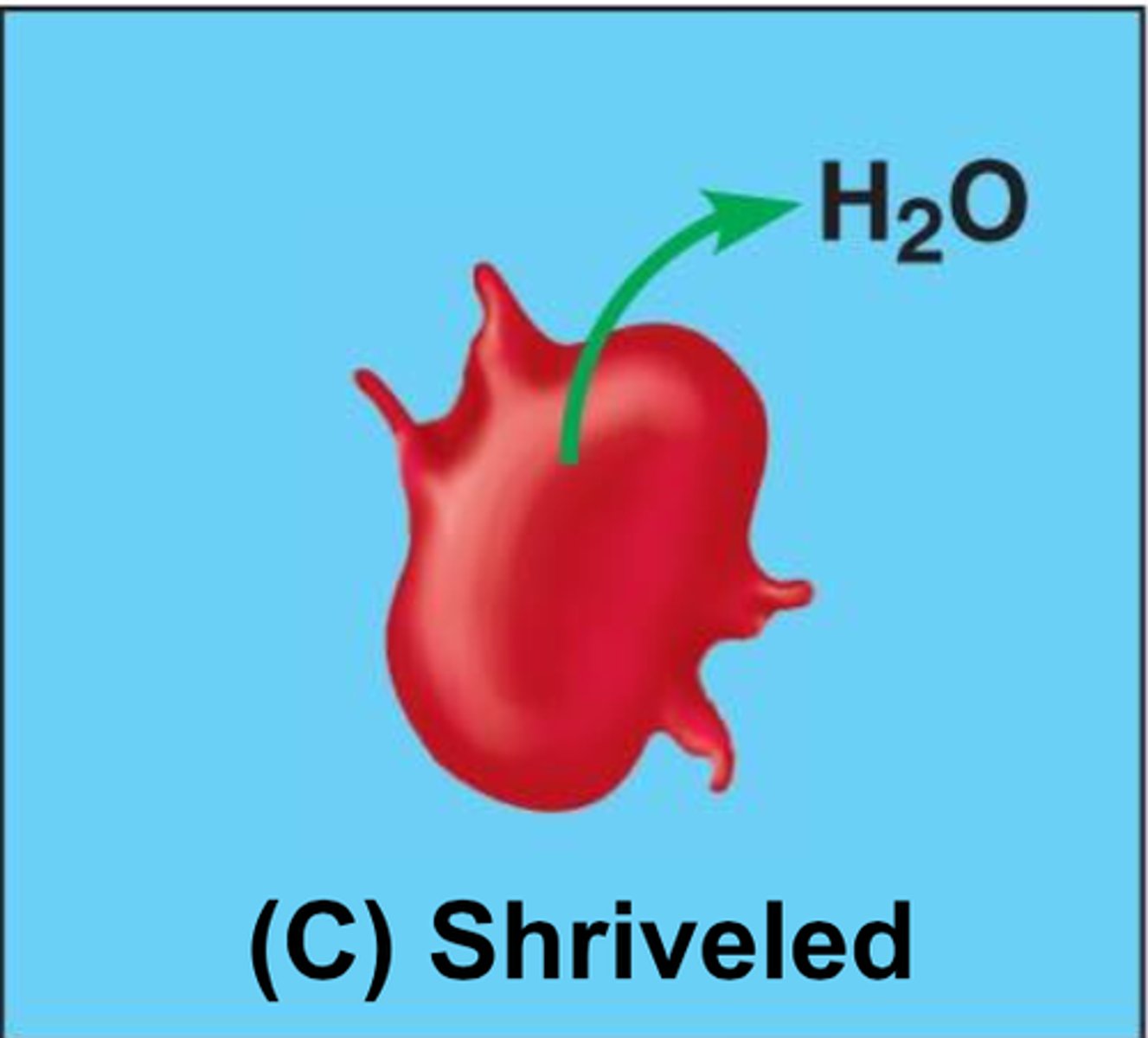Semester 2 Final Exam (Summer '25 Weiland)
1/345
There's no tags or description
Looks like no tags are added yet.
Name | Mastery | Learn | Test | Matching | Spaced |
|---|
No study sessions yet.
346 Terms
Who are the closest ancestors of plants?
Charophycean green algae
What are the homologies between plants and charophycean green algae?
- cell walls = cellulose
- use chlorophylls a & b
- homologous chloroplast structures
- life cycle: alternation of generations
---> 2 different multicellular stages
- sporophyte generation (2n) - make spores
- gametophyte generation (n) - make gametes
What is the sporophyte generation?
- diploid (2n)
- makes haploid spores via meiosis
- spores may/may not be released
- spores develop into the gametophyte generation
What is the gametophyte generation?
- haploid (n)
- makes haploid gametes via mitosis (only new info)
- gametes fuse to produce a zygote (2n) that grows into a new sporophyte
Which generation is prominent?
The prominent generation differs among different types of plants
What are bryophytes?
(e.g. mosses)
- seedless, non-vascular, gametophyte
waxy cuticle: waterproof coating
- sperm swim through standing water to eggs in female part of plant
- the zygote grows within mama plant
----> embryophyte condition - that develops into the sporophyte
- spores are released
What are pterophytes?
(e.g. ferns)
- seedless, vascular, sporophyte
- spores are released
- vascular tissue: bundles of tubes that transport materials
----> xylem: water/minerals move up
----> phloem: sugars move up or down
- lignin: reinforce/support cell walls
- standing water still needed for sperm [sperm = "seed"] (they can live places, but can't reproduce places)
What are gymnosperms?
(e.g. pine tree)
- vascular, "naked seeds", sporophyte
- spores retained in cones & develop into gametophytes
----> ovulate cones - contain ovules which contain an egg
----> pollen cones - make pollen: male gametophyte - makes sperm
- pollen distributed via wind/water
- pollination: pollen lands on the ovulate cone (of same species)
- pollen then produces a pollen tube that grows toward the ovule (not taxis bc it grows in response to stimuli not "moving" in response to stimuli)
- fertilization occurs within the ovule
--> zygote --> embryo (sporophyte)
- ovules develop into seeds: dormant plant embryo & food supply within a durable seed coat
- "naked" gameosperm seeds are distributed via wind/water
What are angiosperms?
(e.g. orange tree - has flower & fruit)
- vascular, "vesseled seed", sporophyte
- spores retained within flowers & become gametophytes
----> male: pollen-transferred by animal pollinators (coevolutionary links)
----> female: embryo sac - 7 cells/8 nuclei
- includes an egg (n)
- includes a cell with 2 nuclei (n + n)
After pollination (pollen on stigma)
- 2 sperm are released
- they travel through the pollen tube
--> from stigma
----> down style
-------> to ovary
-----------> to ovule
---------------> to fertilize the egg
never going to be tested on this (^) it's more important to understand floral structure and what they're for
- "double fertilization"
-- 1 sperm + 1 egg = zygote (2n)
-- 2nd sperm + cell w/ 2 nuclei
----> endosperm (n + n + n = 3n) -> triploid
------------> food supply for the seed
-- ovules develop into seeds
-- flowers develop to fruits:
----> form from the ovary (typically)
----> aid in seed dispersal
name the flower parts
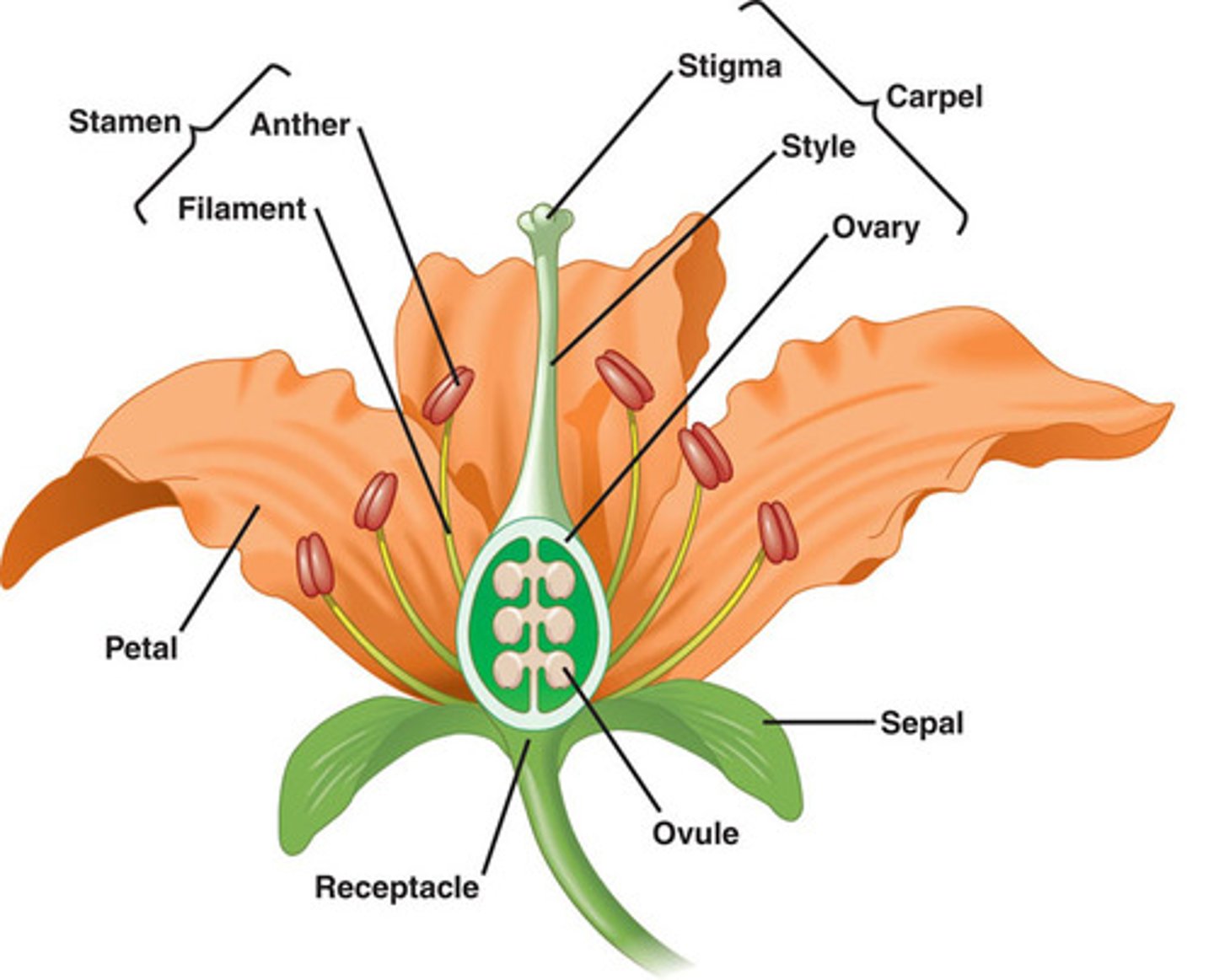
What is ecology? What are the different levels it can be studied?
study of "home"
- organism
- population
- community
- ecosystem
- biomes
- biosphere
What is the ecology study of organism?
organism: single species (anywhere)
--> common niche: sum of all biotic & abiotic factors required for survival
What is the ecology study of population?
population: same species living in the same place (biotic only)
- interactions are intra-specific:
--> e.g. competition, communication, courtship, parental care, etc.
- population growth patterns: --> carrying capacity: maximum predicted population size
What is the ecology study of community?
community: different species/populations living in the same place (only biotic)
- interactions are inter-specifc:
--> e.g. competition - occurs due to niche overlap between species - triggers competitive exclusion
--> e.g. predation, parasitism, mutualism, etc.
What is the ecology study of ecosystem?
ecosystem: includes all biotic and abiotic factors in an environment
--> includes the movement of both energy & nutrients
What is the ecology study of biomes?
biomes: different types of ecosystems
--> e.g. desert, tundra, grasslands, etc.
What is the ecology study of biosphere?
biosphere: area above & below Earth's surface where life is found
--> all biomes considered together
What is the trophic pyramid in ecosystem dynamics?
trophic pyramid:
- reveals feeding relationships among organisms
- includes decomposers/detrivores/sapbrobes at any consumer level
--> energy only makes a 1-way trip
--> nutrients are recycled
What is the nitrogen cycle?
the series of processes by which nitrogen and its compounds are interconverted in the environment and in living organisms, including nitrogen fixation and decomposition
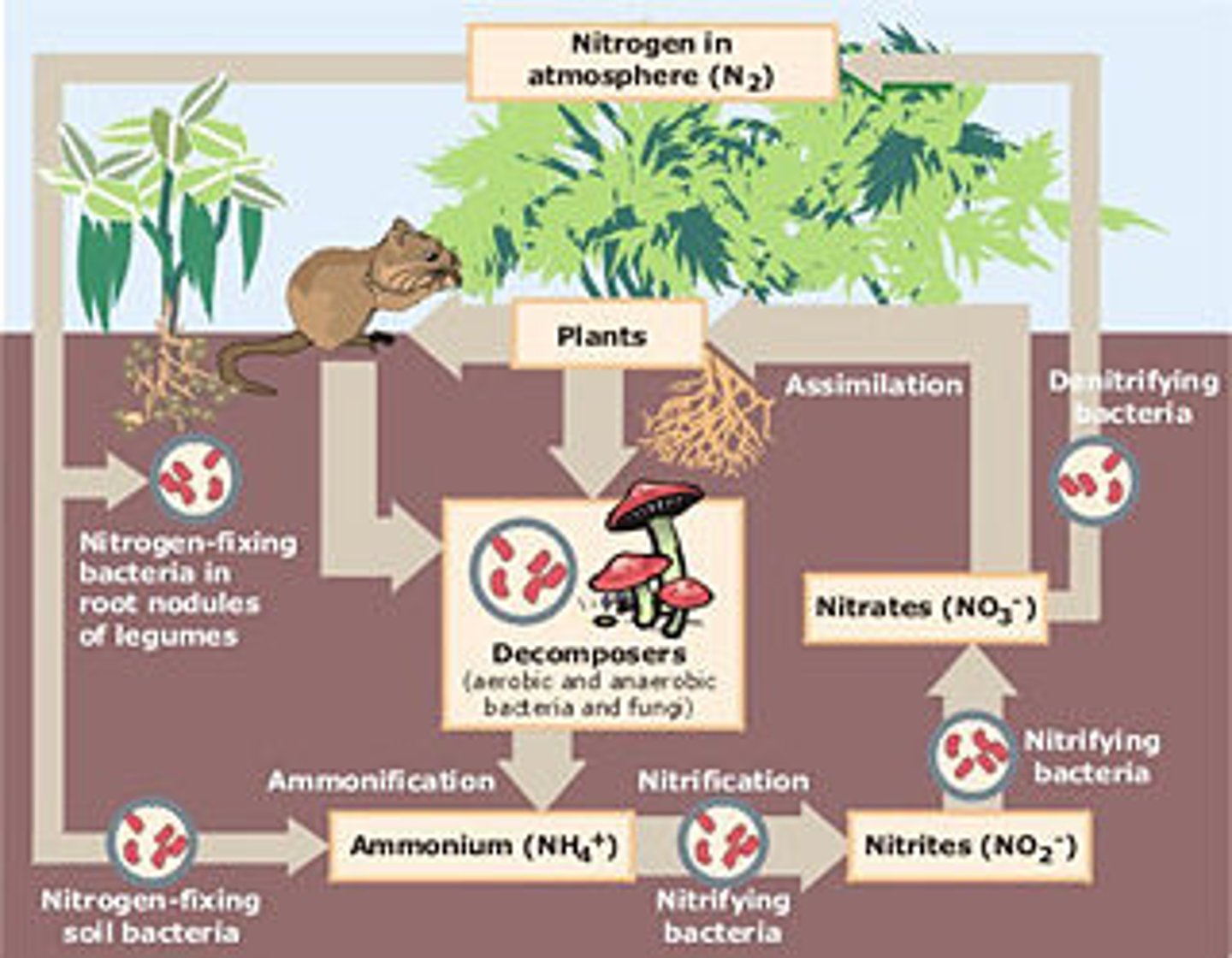
What is the carbon cycle?
the series of processes by which carbon compounds are interconverted in the environment, chiefly involving the incorporation of carbon dioxide into living tissue by photosynthesis and its return to the atmosphere through respiration, the decay of dead organisms, and the burning of fossil fuels.
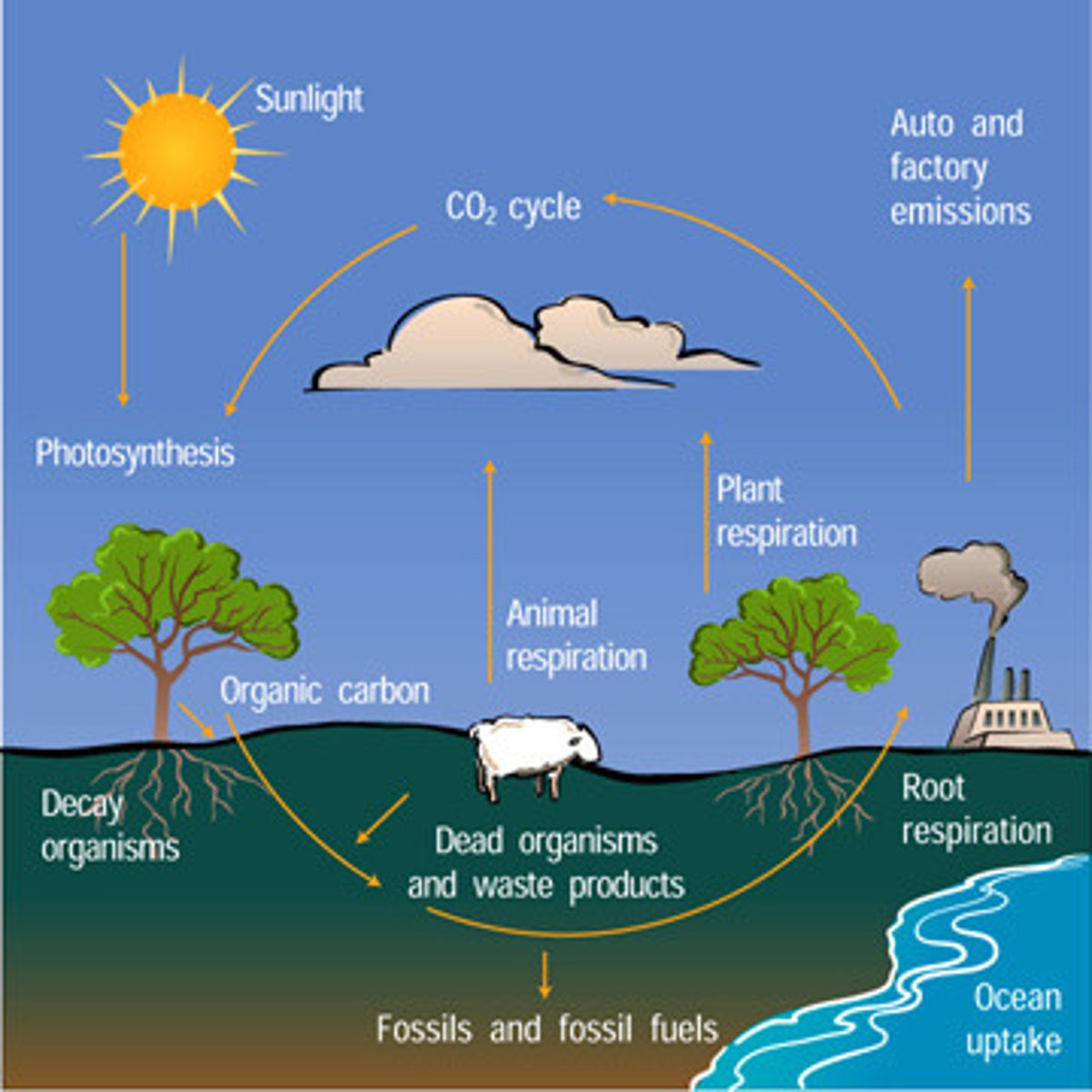
What is the order of consumers/trophic pyramid in ecology?
top to bottom:
- quaternary consumers
- tertiary consumers
- secondary consumer
- primary consumers
- producers
the sun
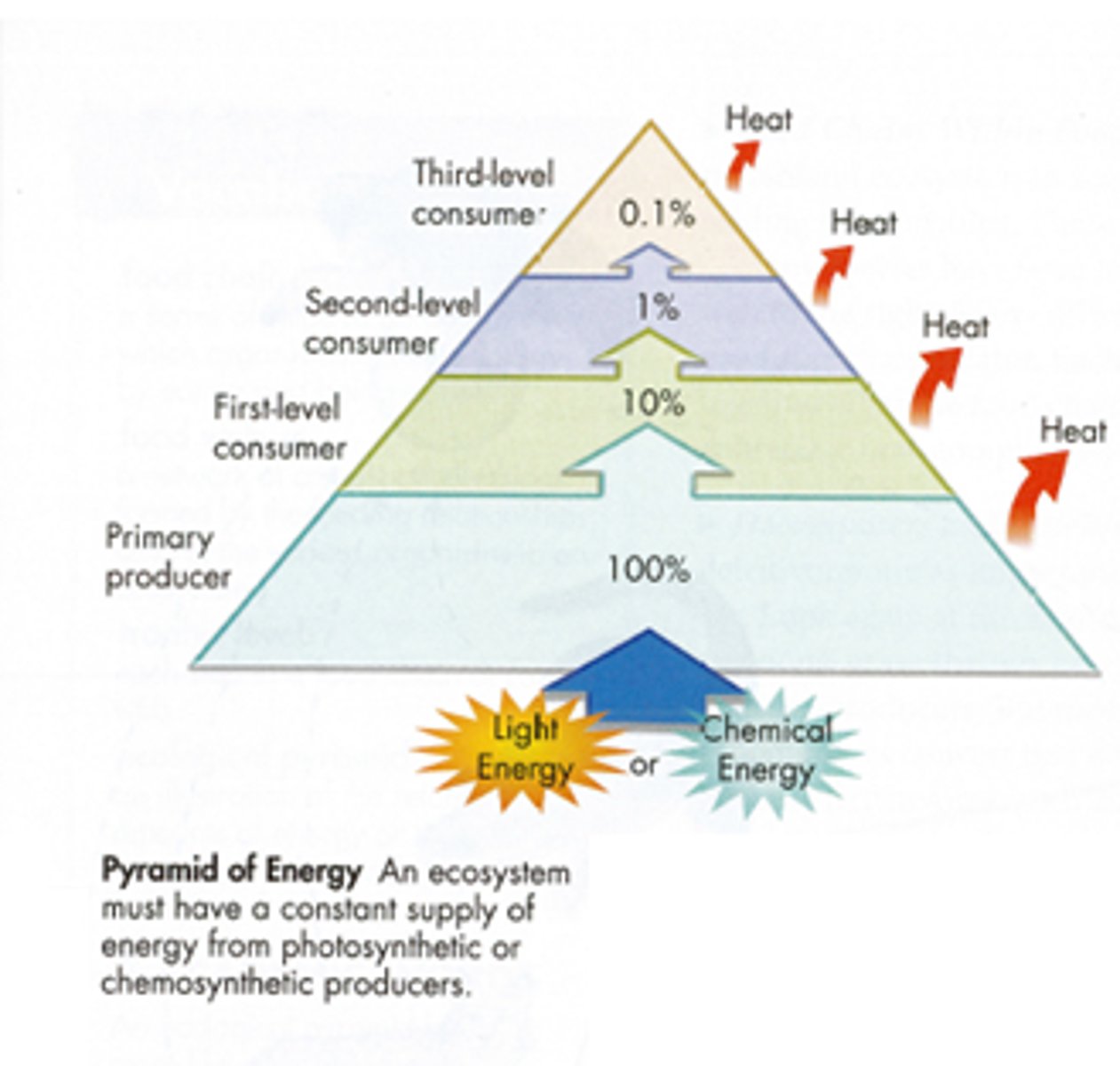
What is the energy/pyramid?
- majority of energy at one trophic level will be used by those organisms to survive/reproduce
--> 10% = only ~10% of the energy available at 1 trophic level can be passed to the next
--> this impacts the number of organisms at higher trophic levels
What is the numbers pyramid?
- dependable decrease in the sustainable population size at higher trophic levels
--> due to the decrease in energy at these trophic levels
What is a biomass pyramid?
- biomass = the amount of living organic material in an ecosystem
-- is a common way to measure the productivity of an ecosystem
-- there is a dependable decrease in the biomass present at higher trophic levels
What is oxidation and reduction in redox reactions?
Oxidation:
- electron loss
- symptom: H+ loss
(bonds broken)
(energy loss)
Reduction:
- electron gain
- symptom: H+ gain
(bonds formed)
(energy gain)
These always occur together ->> "redox" reactions

What does cellular respiration oxidize and reduce? What type of reaction is this? What are the benefits of the many small steps?
- oxidizes glucose into CO2
- reduces O2 into H2O
an exothermic process
benefits of many small steps:
- slow release of energy from food
- allows capture of this energy
--->>> energy is often released in the form of "high energy electrons" (HEe-)
What is the cellular respiration equation? what gets oxidized? what gets reduced?
C6H12O6 + 6O2 ->->->->-> 6CO2 + 6H2O + ATP
(many arrows symbolize cellular respiration is a "redox" metabolic pathway)
C6H12O6 (glucose) gets oxidized to CO2 (carbon dioxide)
O2 (oxygen) gets reduced to H2O (water)

What is the role of electron shuttles? How do they work?
Electron shuttle molecules help control the energy/electron transfer:
- temporarily pick up HEe-
-->> are then reduced & unavailable
- deliver HEe- to some other stage of the pathway
-->> are then oxidized & available
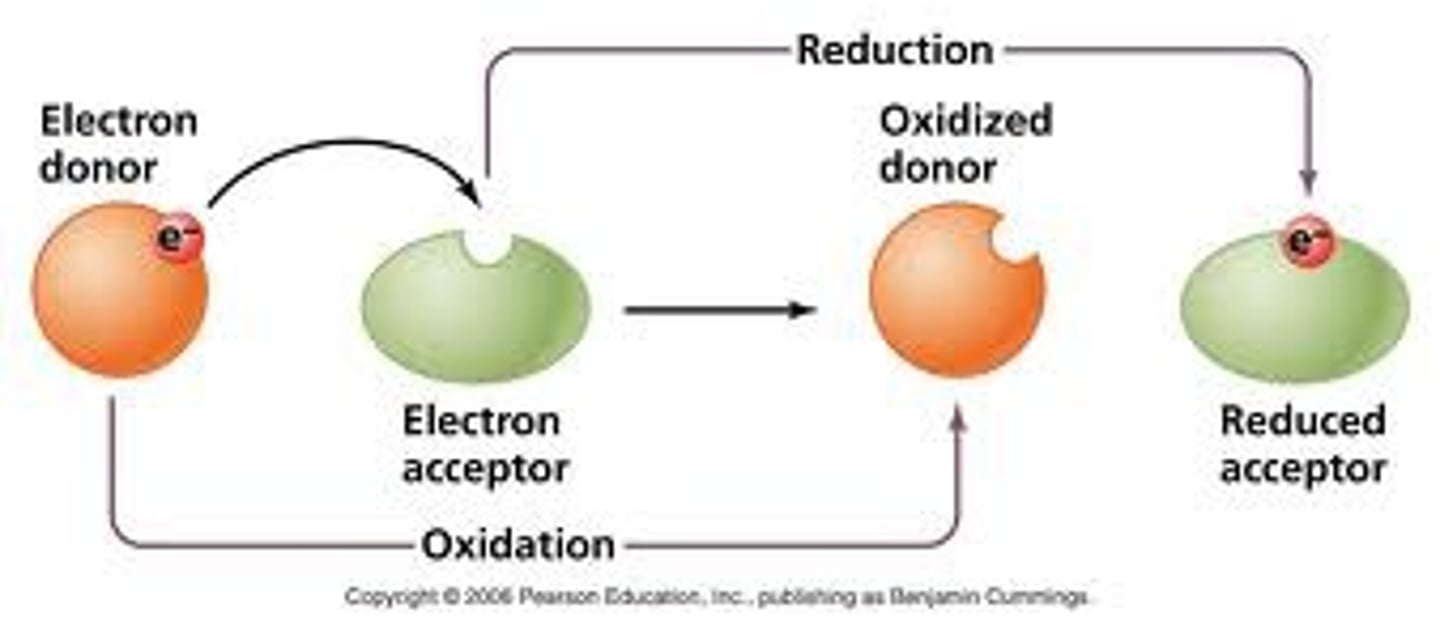
what are the two electron shuttles involved in cellular respiration?
NAD+ (Nicotinamide adenine dinucleotide)
NAD+ + 2HEe- + 2H+ <----> NADH + H+
(oxidized & avail.) <----> (reduced and unavail.)
FAD (flavin adenine dinucleotide)
FAD+ + 2HEe- + 2H+ <----> FADH2
(oxidized & avail.) <----> (reduced and unavail.)
Describe the roadmap of glycolysis, fermentation, and cellular respiration
Glycolysis -> 2 pyruvate
2 pyruvate
-> fermentation (in prokaryotes or eukaryotes with no O2)
-> cellular respiration (eukaryotes with O2)
Fermentation -> 2 lactate or 2 alcohol + 2CO2 (produces no ATP)
Cellular respiration (produces 6CO2 and 36 ATP)
-> pyruvate fixation
-> krebs cycle
-> electron transport chain
-> chemiosmosis
What is glycolysis? Where does it occur? What are the stages?
- occurs in the cytoplasm of all cells (explains how prok. led to euk.)
- it is a metabolic pathway with no O2 required
- it breaks glucose into 2 molecules of pyruvate/pyruvic acid
- occurs in 2 major stages:
-->> energy investment phase
-->> energy harvest phase
What is the energy investment phase of glycolysis?
(phase with no redox!)
- 2 ATP invested
- breaks glucose into 2 G3P molecules (glyceraldhyde 3-phosphate)
What is the energy harvest phase of glycolysis?
- 2 G3P are oxidized -->> 2 pyruvate
- 2 NAD+ are reduced -->> 2 NADH & 2 H+
- 4 ATP are made in the process
(4 ADP + 4 P -->> 4 ATP)
What are the total results from 1 glucose in glycolysis?
- 2 pyruvate/pyruvic acid
--->> fate varies (prok., euk., O2 present?)
- 2 NADH + 2 H+
--->> fate varies (prok., euk., O2 present?)
- 2 net ATP
--->> cell can use immediately
What is fermentation? Where does it occur? What is its sole purpose? What are the products?
- follows glycolysis in the cytoplasm of:
-->> prokaryotes
-->> eukaryotes w/ no O2 available
sole purpose:
- to oxidize NADH back to NAD+
(removes e- from shuttles - returning them to an available form)
-allows glycolysis to continue
- the process also converts the 2 pyruvate into either:
-->> 2 lactate/lactic acid
-->> 2 alcohol + 2 CO2
What is cellular respiration? Where does it occur? What does it oxidize and reduce? What are the four stages?
(main function is to make ATP to power cell activities)
- occurs in the mitochondria of eukaryotes with O2 present
- completely oxidizes the 2 pyruvate from glycolysis
---->> 6 CO2
- eventually reduces 6 CO2 ---->> 6 H2O
4 stages:
- pyruvate fixation (in the matrix)
- Krebs cycle/citric acid cycle (in the matrix)
- electron transport chain (in the inner membrane)
- chemiosmosis (in the inner membrane)
What is pyruvate fixation? What are the redox reactions? What are the totals per glucose from this process?
(occurs in the matrix)
--> aka acetyl CoA formation
- oxidizes 2 pyruvate
-->> 2 acetyl CoA + 2 CO2
- reduces 2 NAD+ --> 2 NADH + 2 H+
totals per glucose:
- 2 acetyl CoA
--->> go on to the Krebs cycle
- 2 NADH + 2 H+
--->> go on to the ETC
- 2 CO2
--->> exhaled!
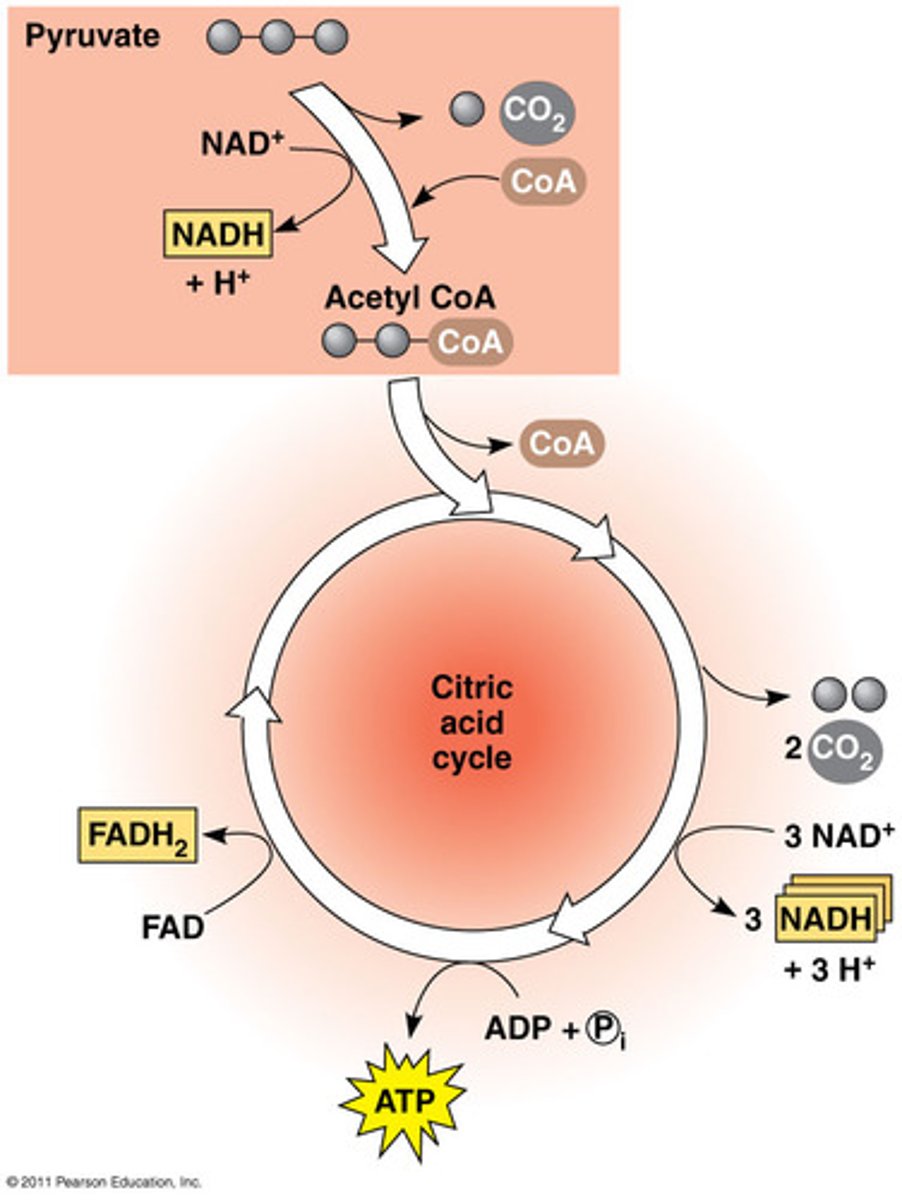
What is the Krebs cycle? What are the redox reactions? What are the totals per glucose from this process?
(occurs in the matrix)
--> aka citric acid cycle
1st step:
- oxaloacetate ("keeps the Kreb cycle alive/going"). + acetyl CoA ("ticket into the Kreb cycle")
--> citric acid
- oxidizes 2 acetyl CoA -->> 4 CO2
- reduces NAD+/FAD -->> NADH / FADH2
-->> (involves numerous electron carriers)
- ATP are also made in the process
- cyclic --->> oxaloacetate gets regenerated so the process an continue
totals per glucose:
- 4 CO2
--->> exhaled!
- 2 ATP
--->> used for cellular work
- 6 NADH + 6 H+ & 2 FADH2
--->> to the ETC!
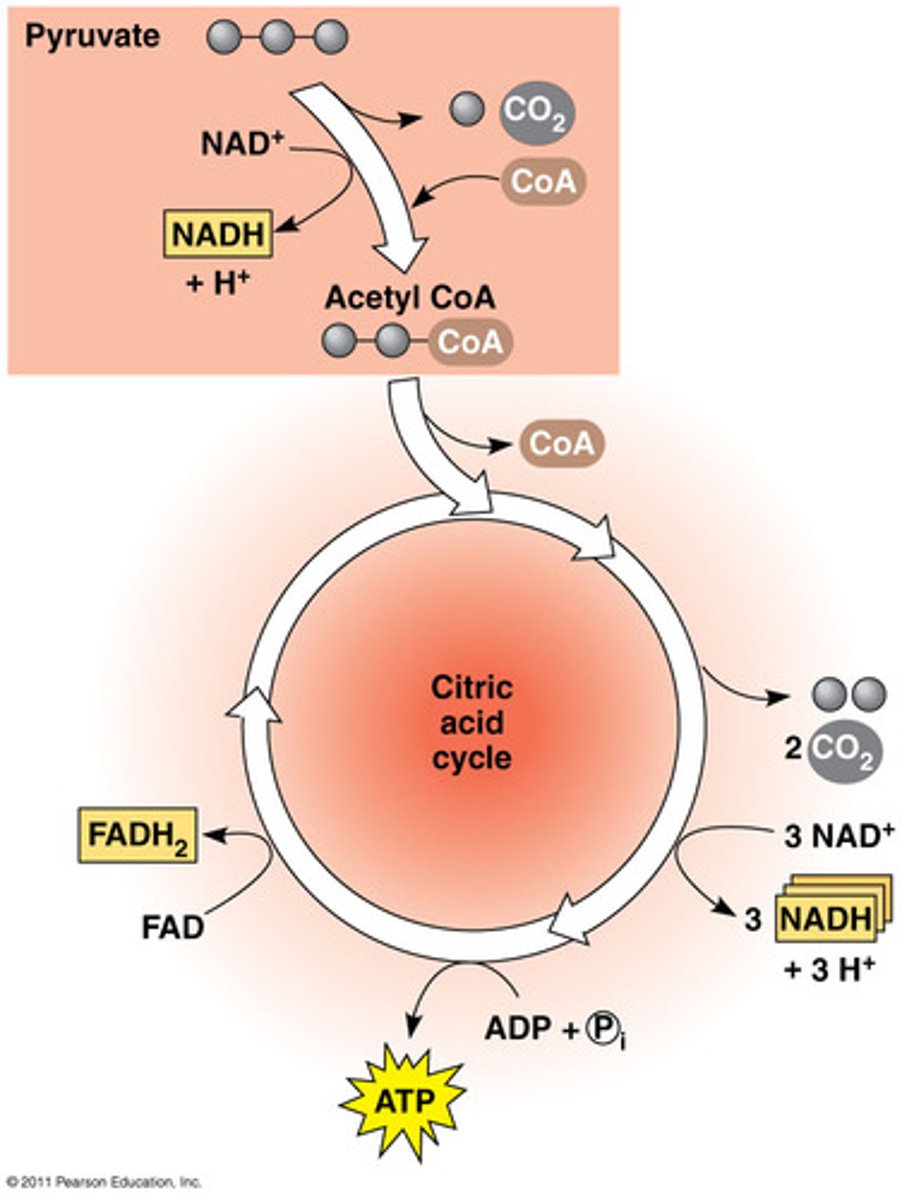
What is the electron transport chain (ETC)? How does it work?
- series of proteins embedded in the inner mitochondrial membrane
- NADH & FADH2 drop off their 2HEe-
--->> NAD+ & FAD = available shuttles!
- pass the 2HEe- on the basis of increasing electronegativity
- only functions if oxygen is available at the end to catch the 2e-
1/2 O2 + 2e- + 2 H+ ---> H2O
- these 2e- must be stripped of their energy by the time they get to O2 ---> "low energy electrons"
- as the HEe- are passed their energy is taken by certain ETC proteins that act as pumps, using the energy to move H+ ---> active transport!
- H+ are pumped from:
--> mitochondrial matrix, across the inner membrane, into the inter-membrane space
Result = H+ gradient that stores potential energy

What is chemiosmosis in cellular respiration? What is involved in the process? What does it produce?
- process of using the energy stored in a H+ gradient to produce ATP
Dependent on ATP synthase:
- acts as a transport protein
-->> facilitates the diffusion of H+ back into the matrix
-->> captures the energy released by the gradient
- acts as an enzyme
-->> joins ADP + P = ATP
-->> yields 32 more ATP per glucose
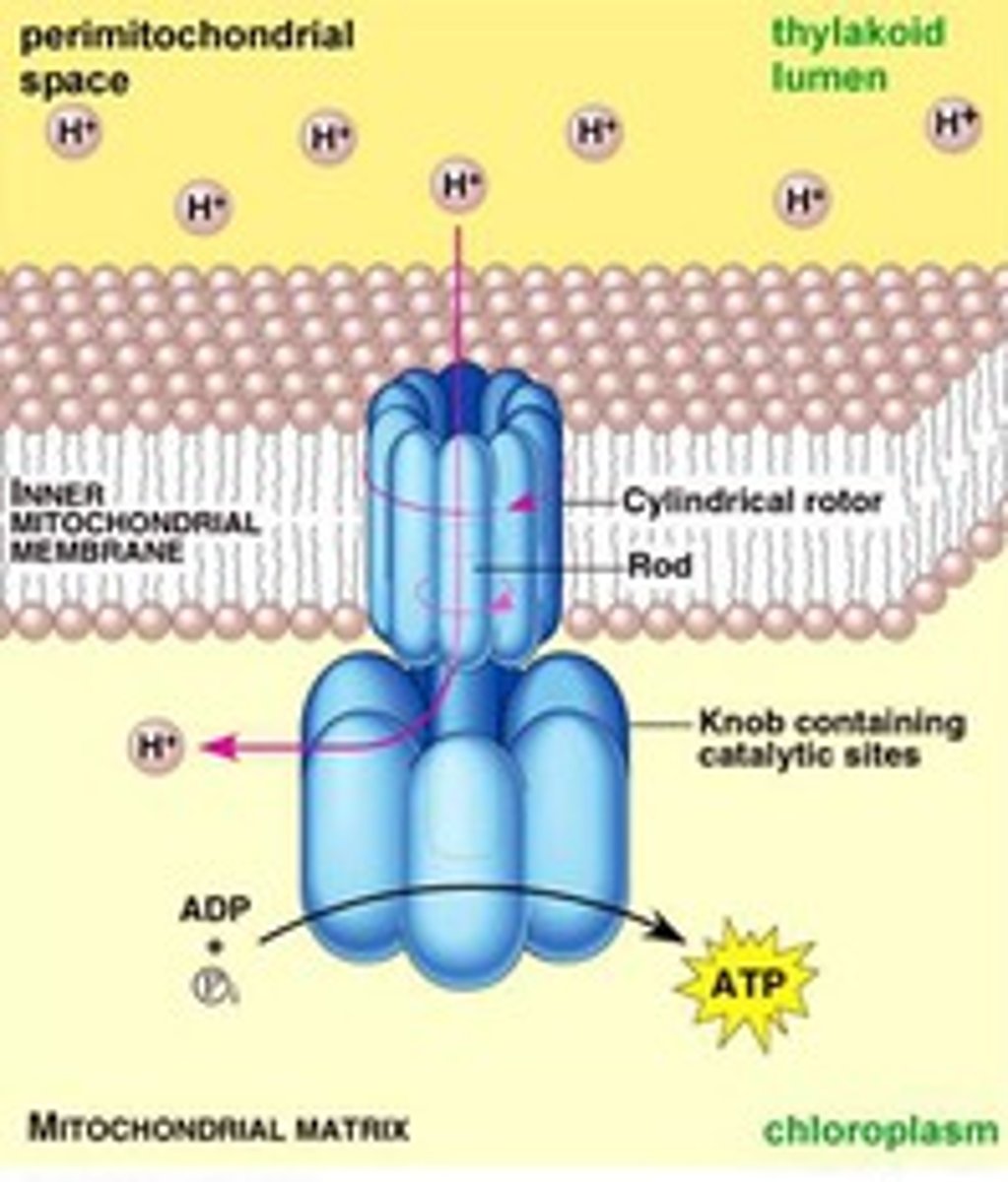
What does photosynthesis oxidize and reduce? What type of reaction is this? What does this process require? What are the stages?
Photosynthesis is a "redox" metabolic pathway
- oxidizes H2O into O2
- reduces CO2 into glucose
endothermic reaction (light energy provides the energy)
process requires an electron shuttle:
--> NADP+ / NADPH
stages of photosynthesis:
there are 2 major stages that occur in different parts of the chloroplasts:
--> light (dependent) reactions
--> light independent reactions / Calvin cycle ("dark reactions")

What is a light (dependent) reaction? where does it occur? What does it use? What does it oxidize? What is its byproduct?
- occurs in the thylakoid membrane
- use photosystems to absorb light & convert it to energy stored in:
-->> ATP & NADPH
- oxidizes H2O (= electron source) producing O2 as a byproduct
H2O ----> 1/2 O2 + 2e- + 2 H+
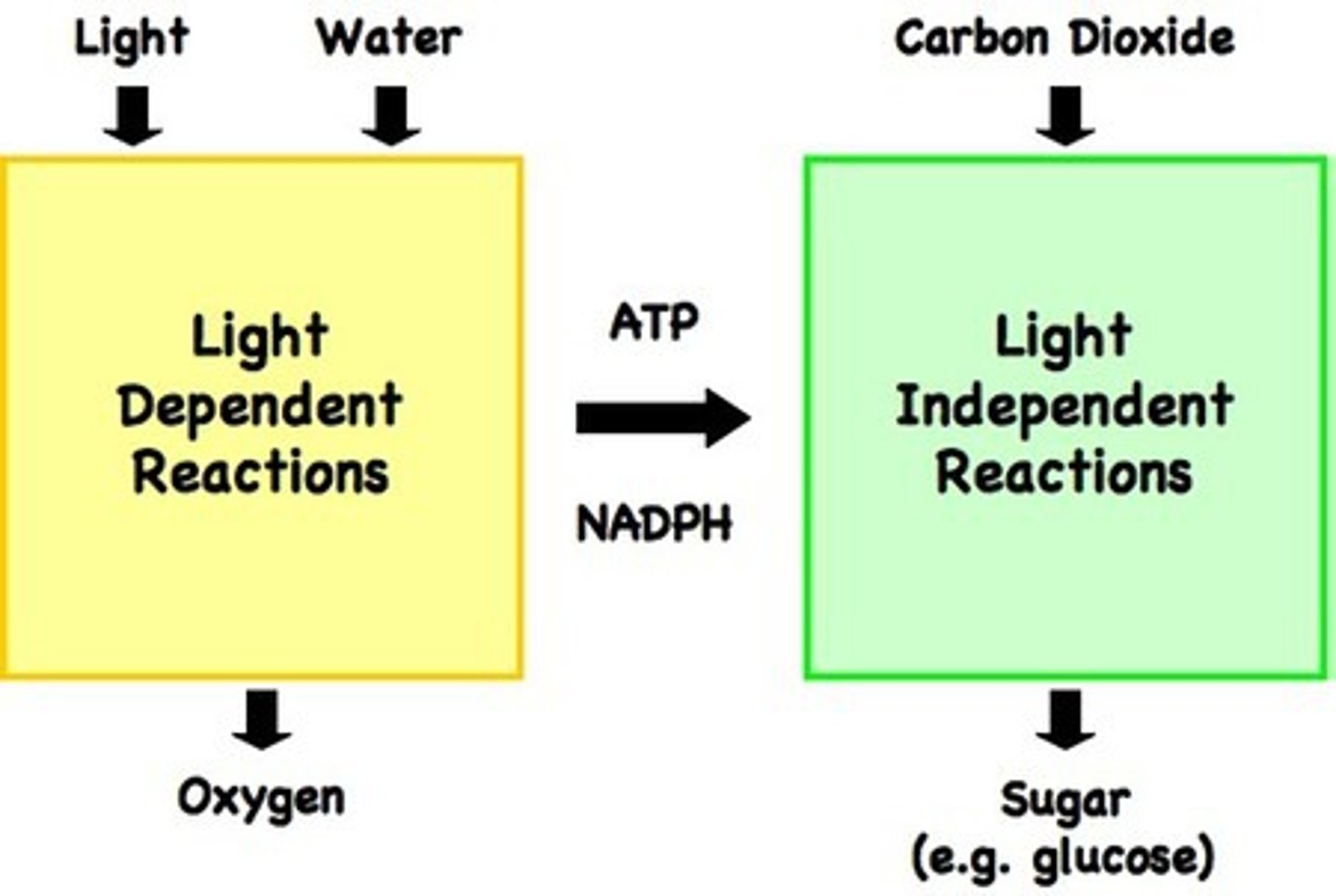
What is a light (independent) reaction? where does it occur? What does it use?
(aka Calvin Cycle / Dark reactions)
- occur in the stroma
- use products of the light reaction:
--> energy from ATP
--> HEe- from NADPH
- reduce CO2 to form sugars
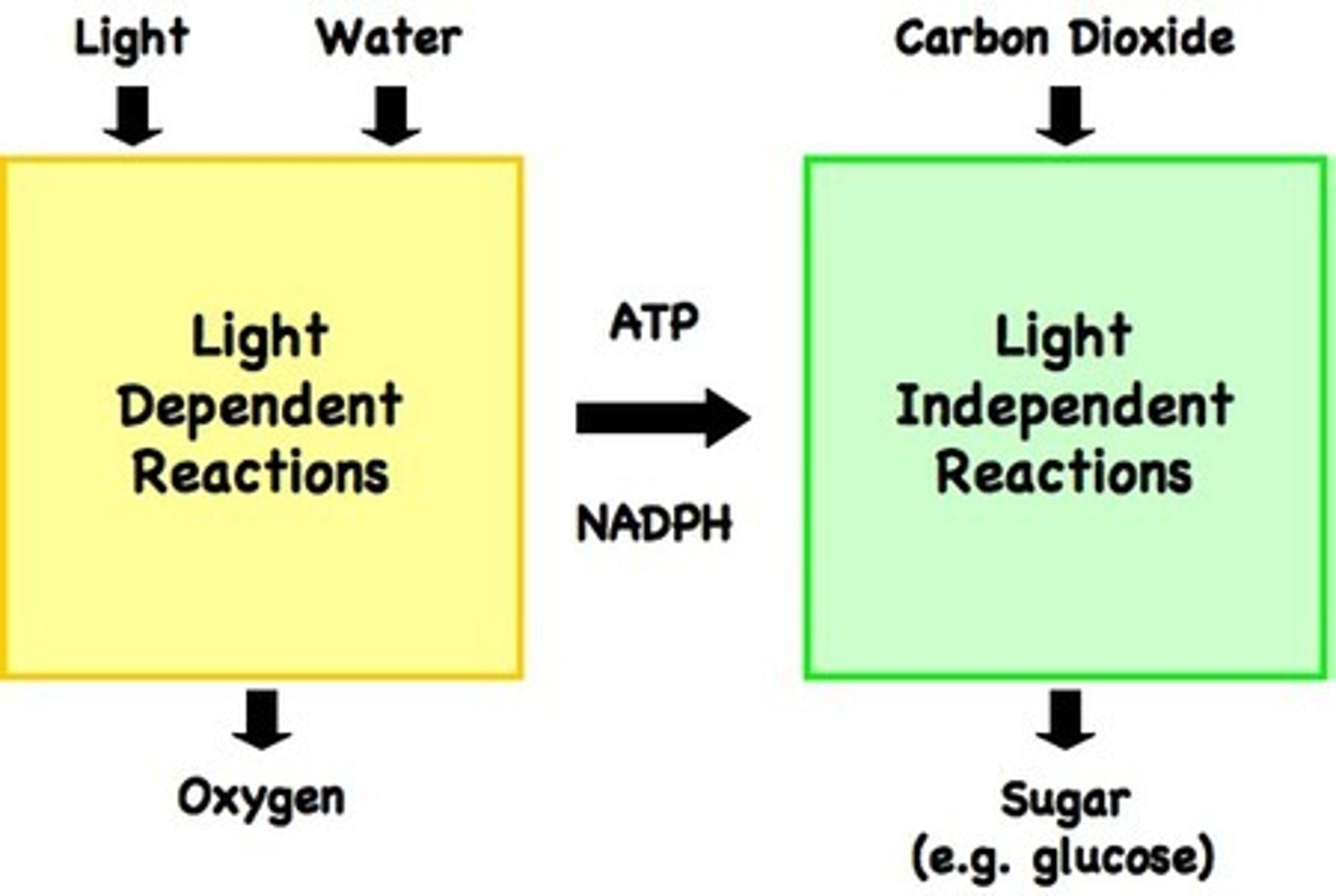
What is light? What are the 2 different manners in which it (visible light) behaves?
light = form of energy within the electromagnetic spectrum
- has dual nature as it travels both:
--> as a type of radiation = waves
--> as bundles of energy = photons
*regardless of from (waves/photons):
-> "white light" is actually a blend of all colors together
-> observable with a prism
What are waves and their measurable features?
Waves are a type of radiation in which light can travel
Waves have measurable features:
- wavelength: distance between two equivalent points
-> determines the color of light
-> corresponds with a particular amount of energy
- inverse relationship between wavelength & amount of energy
What are photons?
photons = bundles of light energy
-> the amount of energy in the photon determines the color
What can happen when light strikes an object?
When light strikes an object it can be:
- reflected
- transmitted
- absorbed
-->> typical for some combination of all three to occur
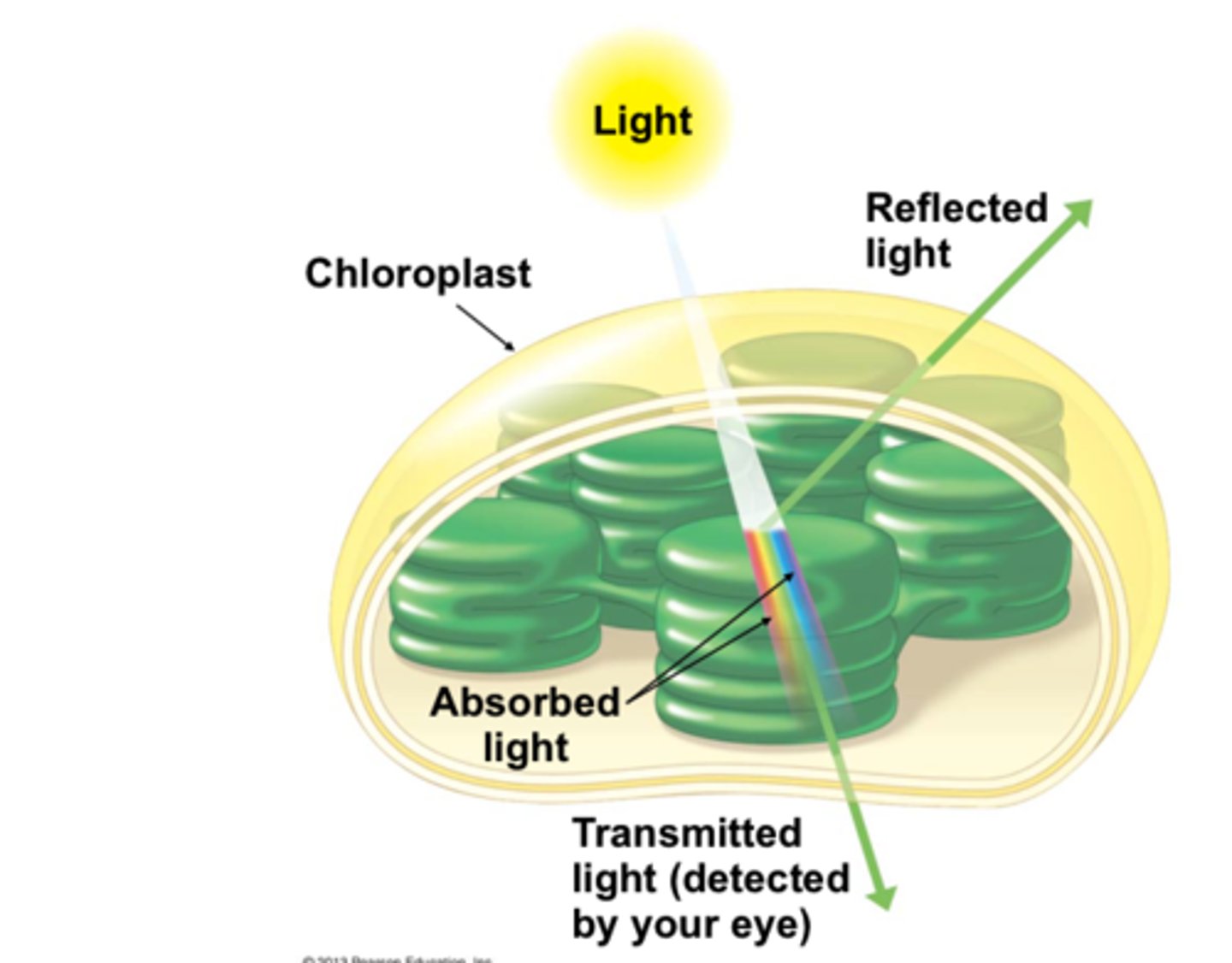
What are pigments? What do they do? What is the result?
pigment = molecules that selectively absorb certain colors of light
-->> reflect and/or transmit others
Result:
- absorbed colors are not visible
- the color rejected is the color seen
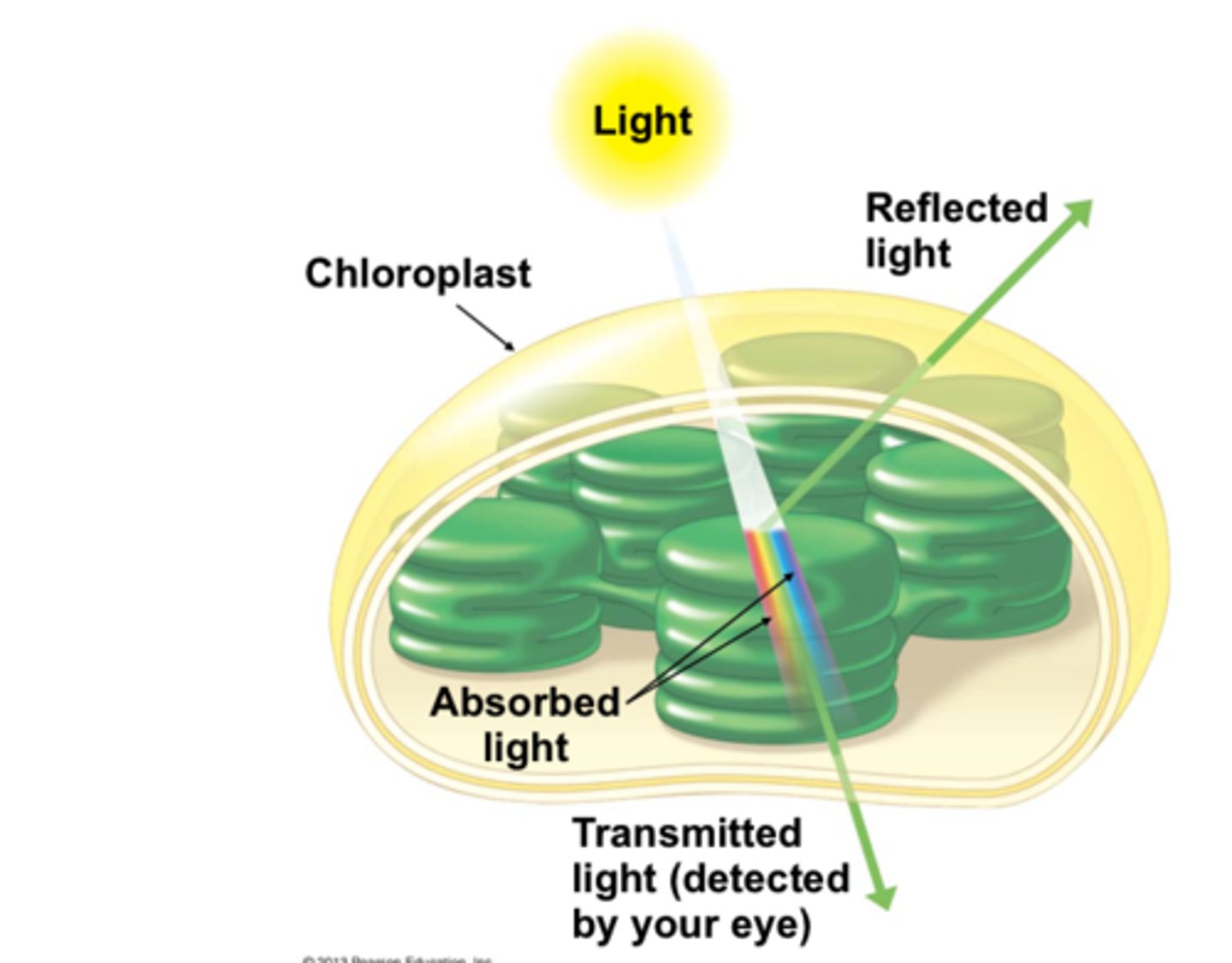
What are photosynthetic pigments? where are they located? What do they do?
- located exclusively within the thylakoid membranes
--> specifically are part of the photosystems embedded there
- capture light to fuel photosynthesis
- absorbed energy is used to "excite" electrons (=HEe-)
What are chlorophylls? what are the primary types? what do they do?
- pigment family with green hues
- chlorophylls a & b -->> primary photosynthetic pigments used by plants & green algae
- absorbed energy excites its e-
- directly involved in the conversion of light energy to chemical energy
What are accessory pigments?
- non-chlorophyll pigments within photosystems in small quantities
-> visible in autumn leaves
-> aid in general light absorption
-> e.g.
-->> carotenoids: orange/yellow
-->> anthocyanins: red/purple
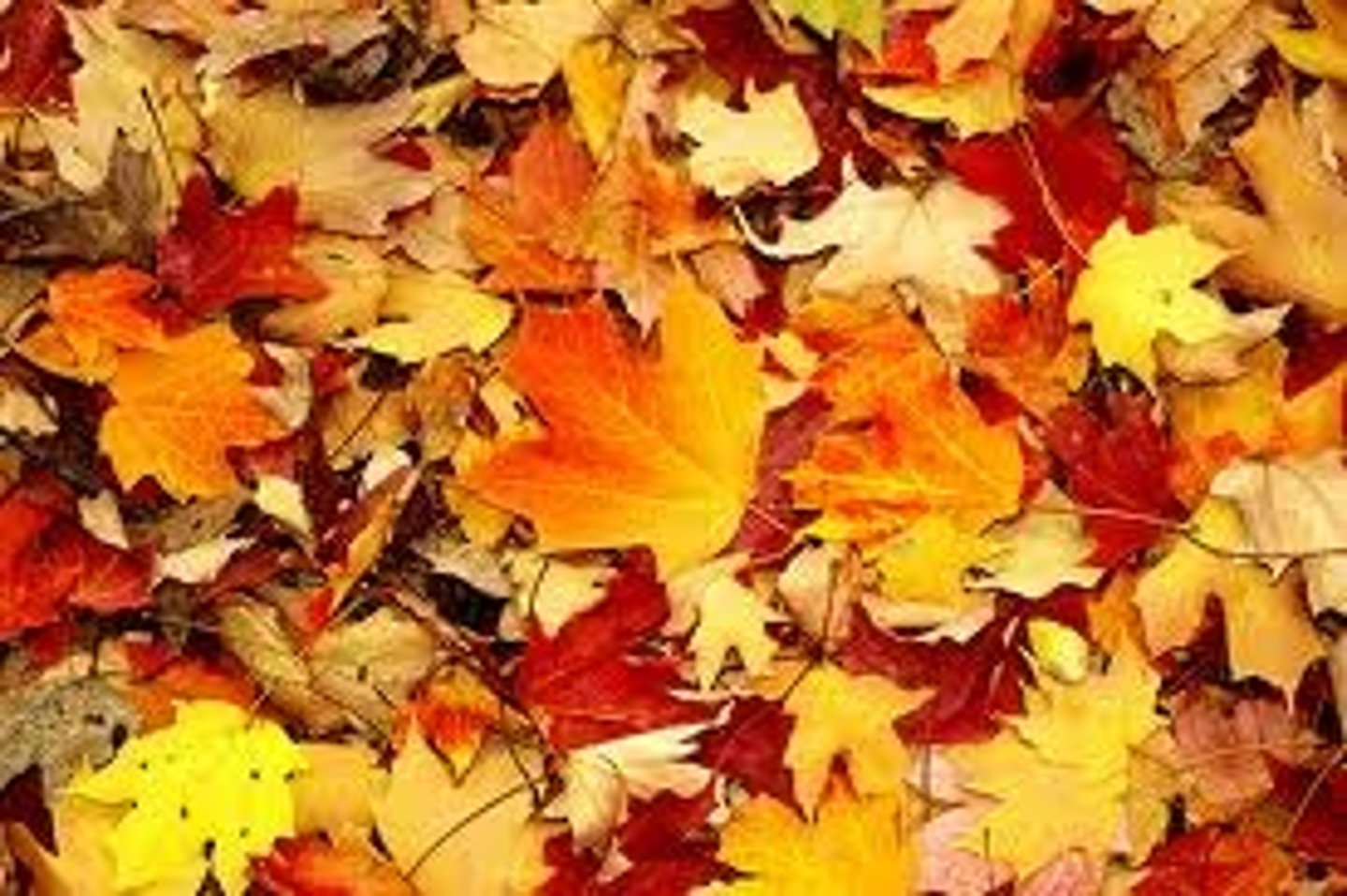
What happens when chlorophyll absorbs photons?
When chlorophyll absorbs photons - the energy "excites" 2 of its e-
-->> causes the 2e- to jump to a higher energy level than normal (HEe-)
- these 2HEe- can either:
-> fall back to their normal state (which just releases the energy)
-> take part in a redox reaction
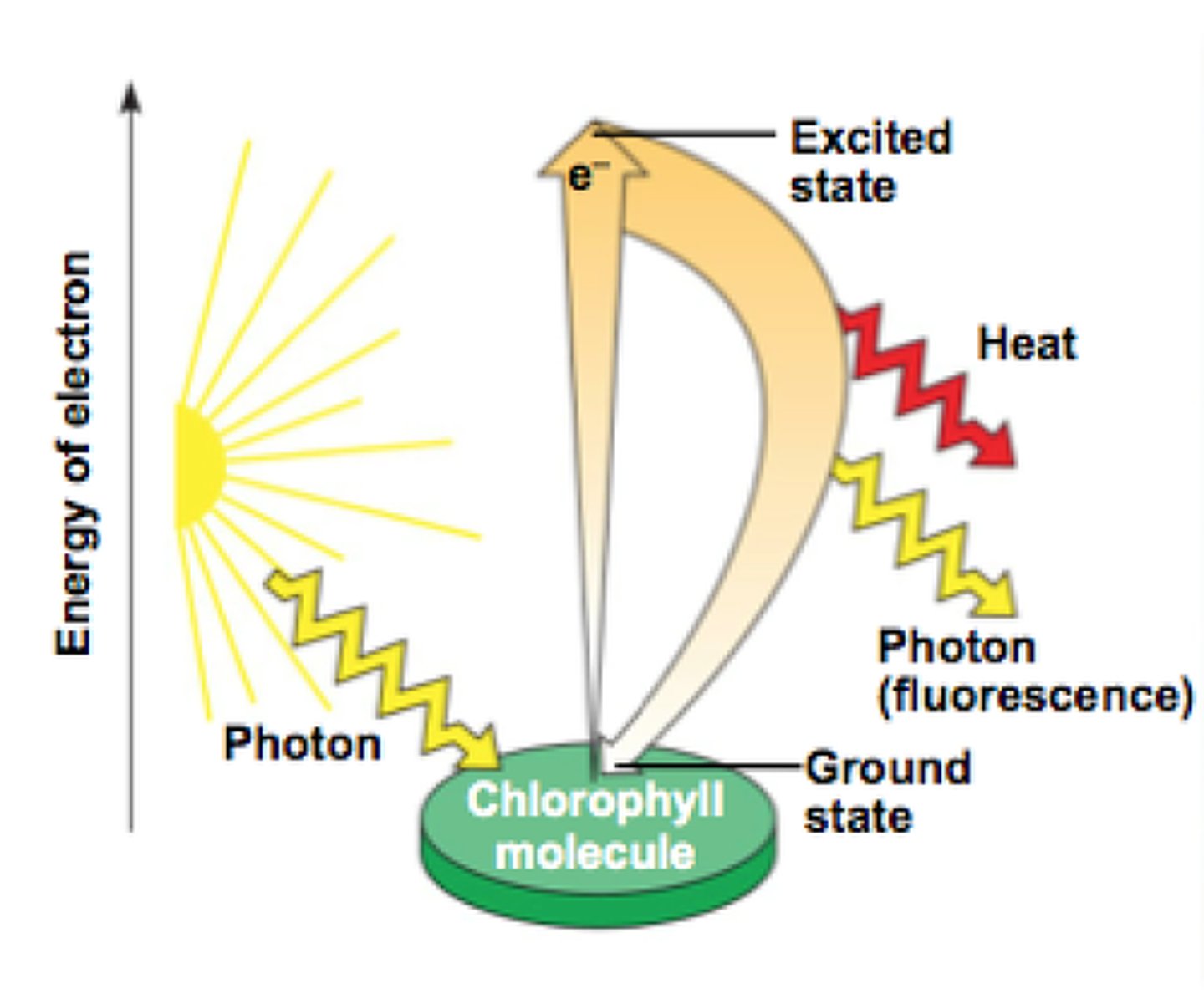
What are photosystems? What are the different structural parts?
photosystems = clusters of pigments & proteins embedded in thylakoid membranes
- light reactions occur here
- structure has 3 parts:
--> antenna complex
--> reaction center chlorophyll
--> primary electron acceptor
- followed by an ETC
What is the antenna complex? What is its role?
- hundreds of chlorophylls & accessory pigments together
- absorb light & bounce energy from pigment to pigment
- eventually pass the energy to the reaction center chlorophyll
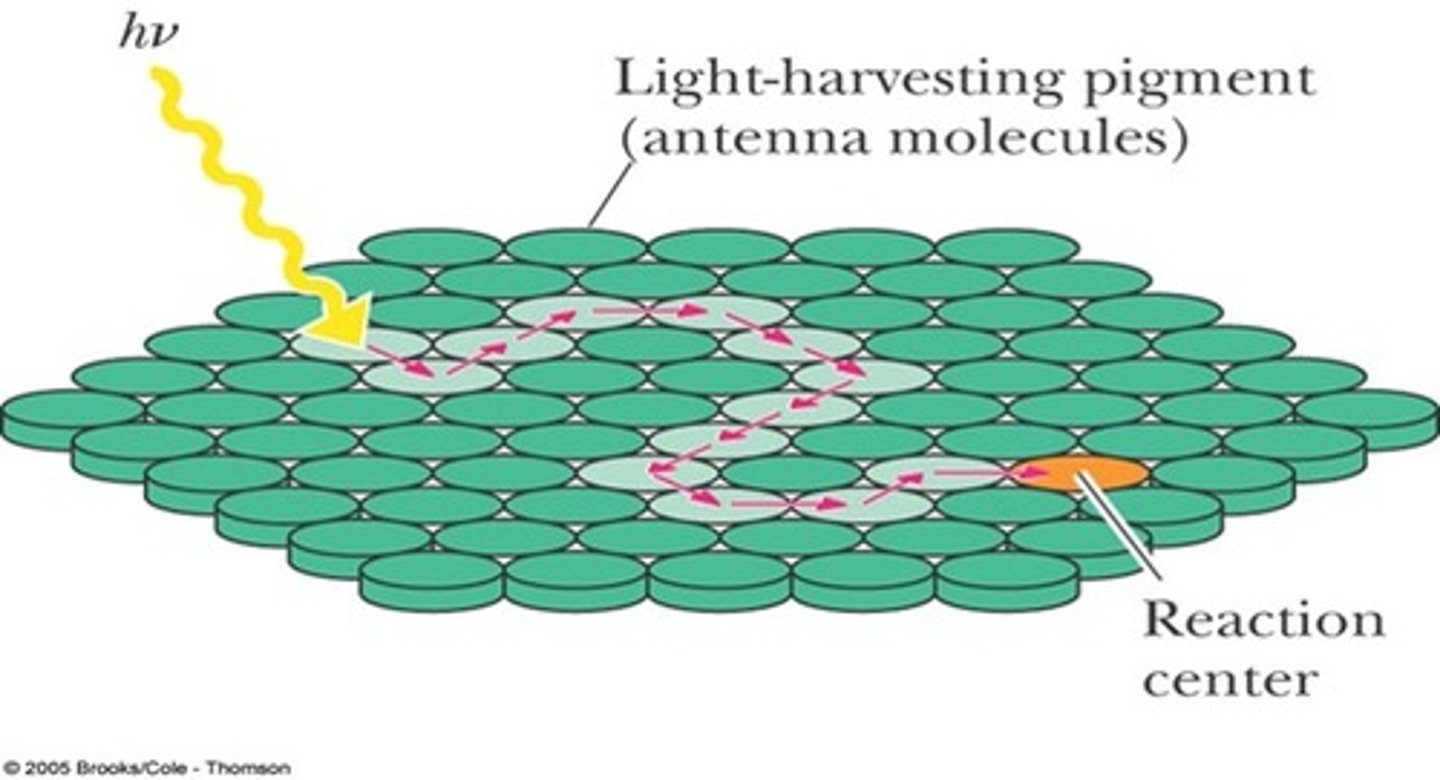
What is the reaction center chlorophyll? What is its role?
- absorbs energy from the antenna pigments
--> exciting 2e- --> 2HEe-
- gets oxidized -> losing the 2 HEe-
- its 2 HEe- are caught by the primary electron acceptor
- this redox reaction converts light to chemical energy (energy stored in a bond)
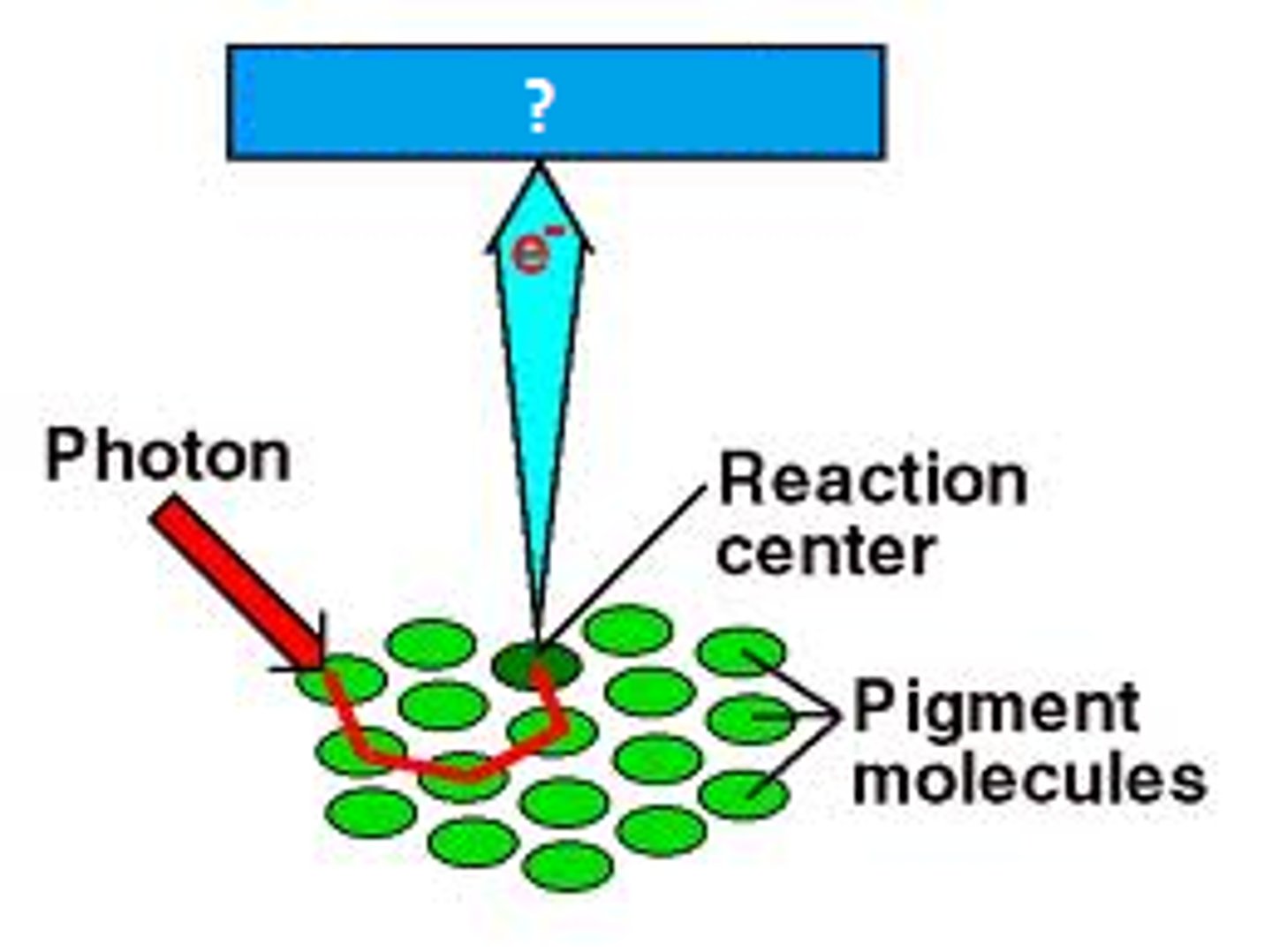
What is the primary electron acceptor ? What is its role?
- reduced in the redox reaction by catching the 2 HEe- from the reaction center chlorophyll
- passes these 2 HEe- on to an ETC that follows the photosystem
What are light reaction involved in photosynthesis? What are the two photosystems and how do they differ?
- involve a combination of 2 different photosystems, 2 ETC's, & chemiosmosis - all within thylakoid membrane
The photosystems:
- NADPH producing photosystem (P1)
- water-splitting photosystem (P11)
They differ regarding:
--> direct electron source
--> electron destination after the ETC
What occurs in the NADPH producing photosystem (P1)? what happens after the photosystem?
- the 3 parts of the photosystem do their job as expected
After this photosystem:
- a very short ETC delivers the 2 HEe- to
NADP+ ---> NADPH + H+ (e- destination)
- the reaction center chlorophyll is reloaded with 2e- from the other photosystem via another ETC (e- source)
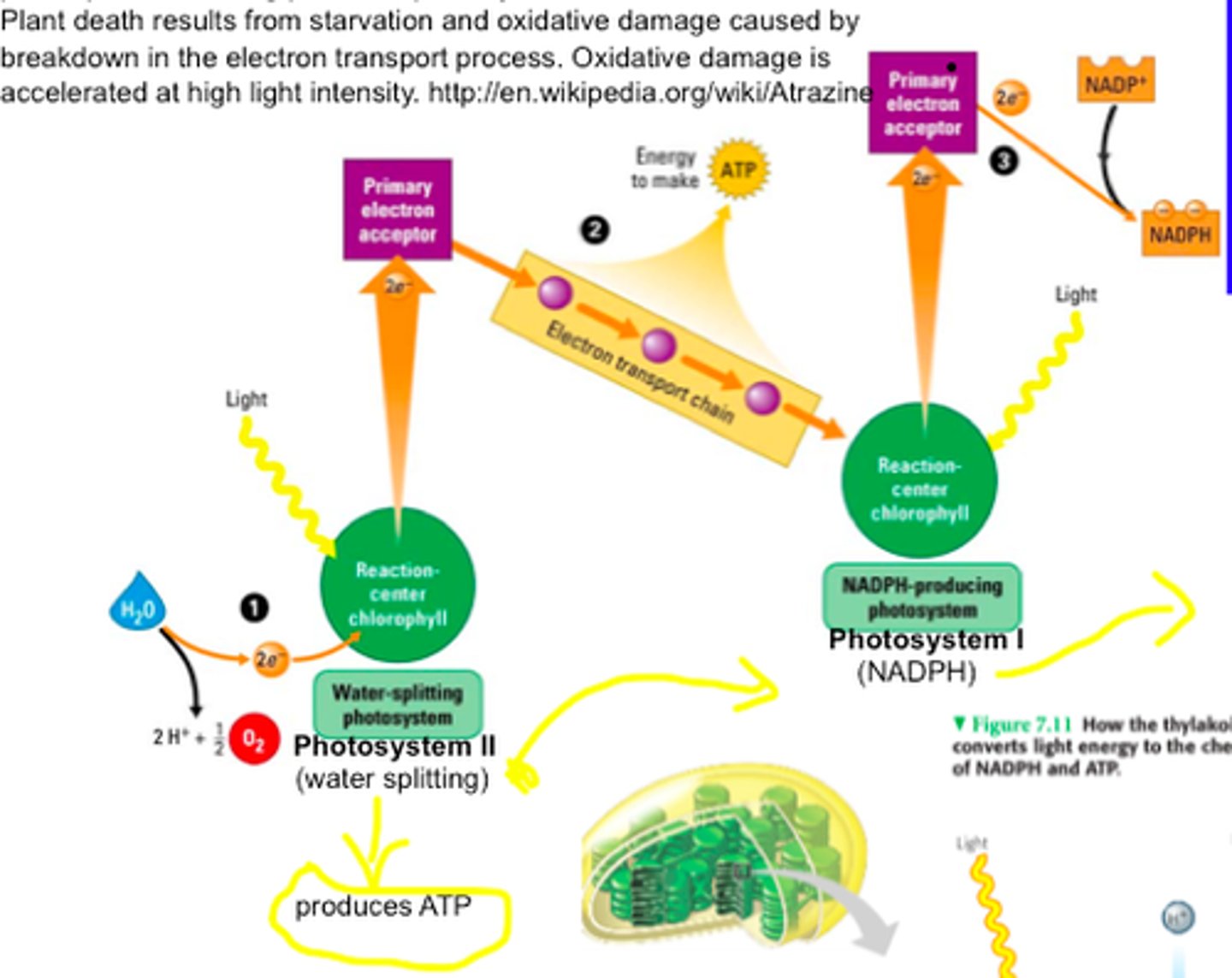
What occurs in the water-splitting photosystem (P11)? what happens after the photosystem?
- the photosystem works as expected
After this photosystem:
- a long ETC (in the thylakoid membrane) delivers the 2e- to the reaction center in the NADPH producing photosystem (e- destination)
- the reaction center chlorophyll is reloaded with 2e- directly from H2O (e- source)
What is chemiosmosis in photosynthesis?
- there are ATP synthase proteins embedded in thylakoid membranes
--> they facilitate the diffusion of H+ back into the stroma
--> harnesses the energy from the H+ gradient & use it to make ATP (one of the products of the light reactions)
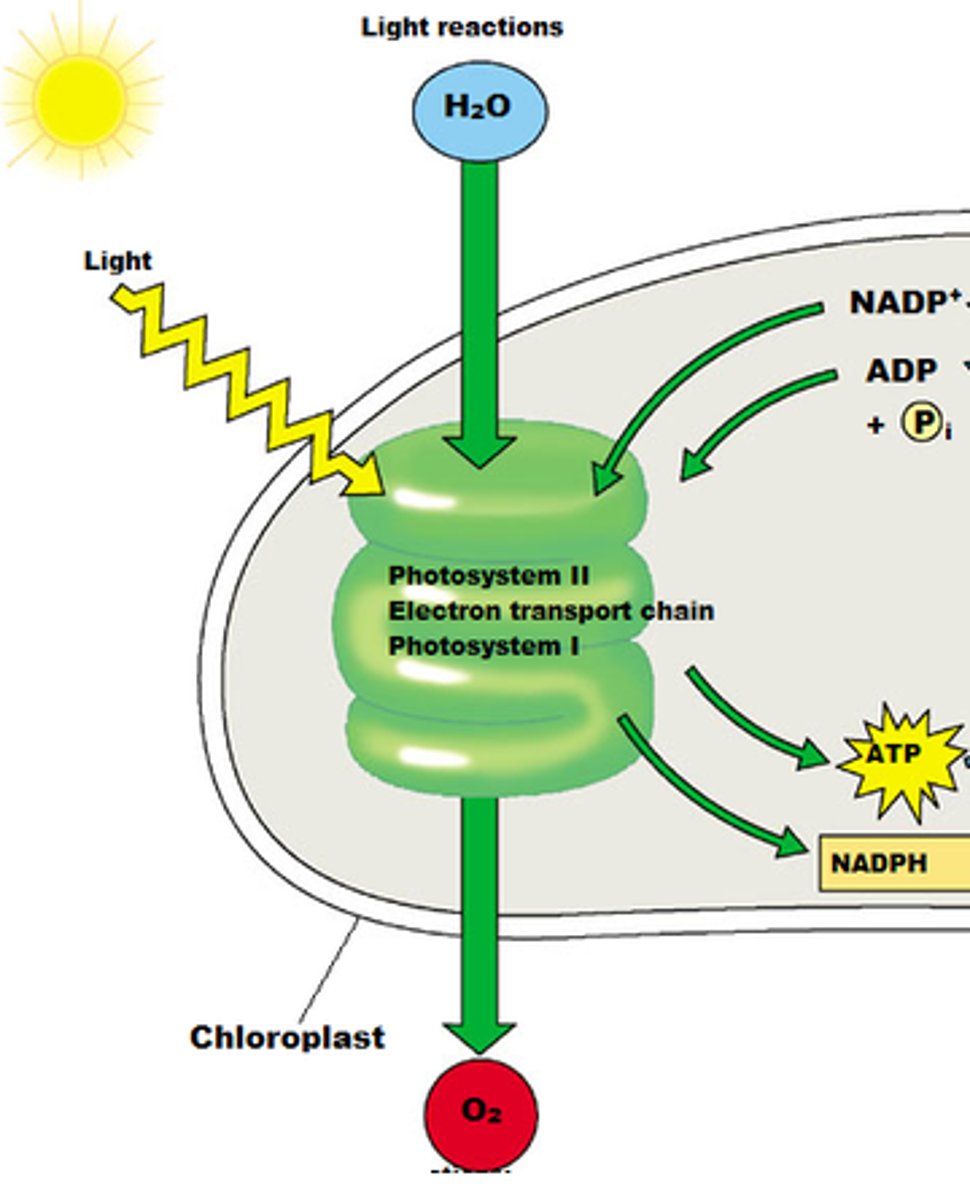
What are the light independent reactions? What are the phases?
(aka Calvin cycle / "Dark" reactions)
- cyclic - so must begin & end with the same molecule: RuBP (ribulose bisphosphate)
- considered in 3 phases:
-->> carbon fixation
-->> reduction
-->> regeneration
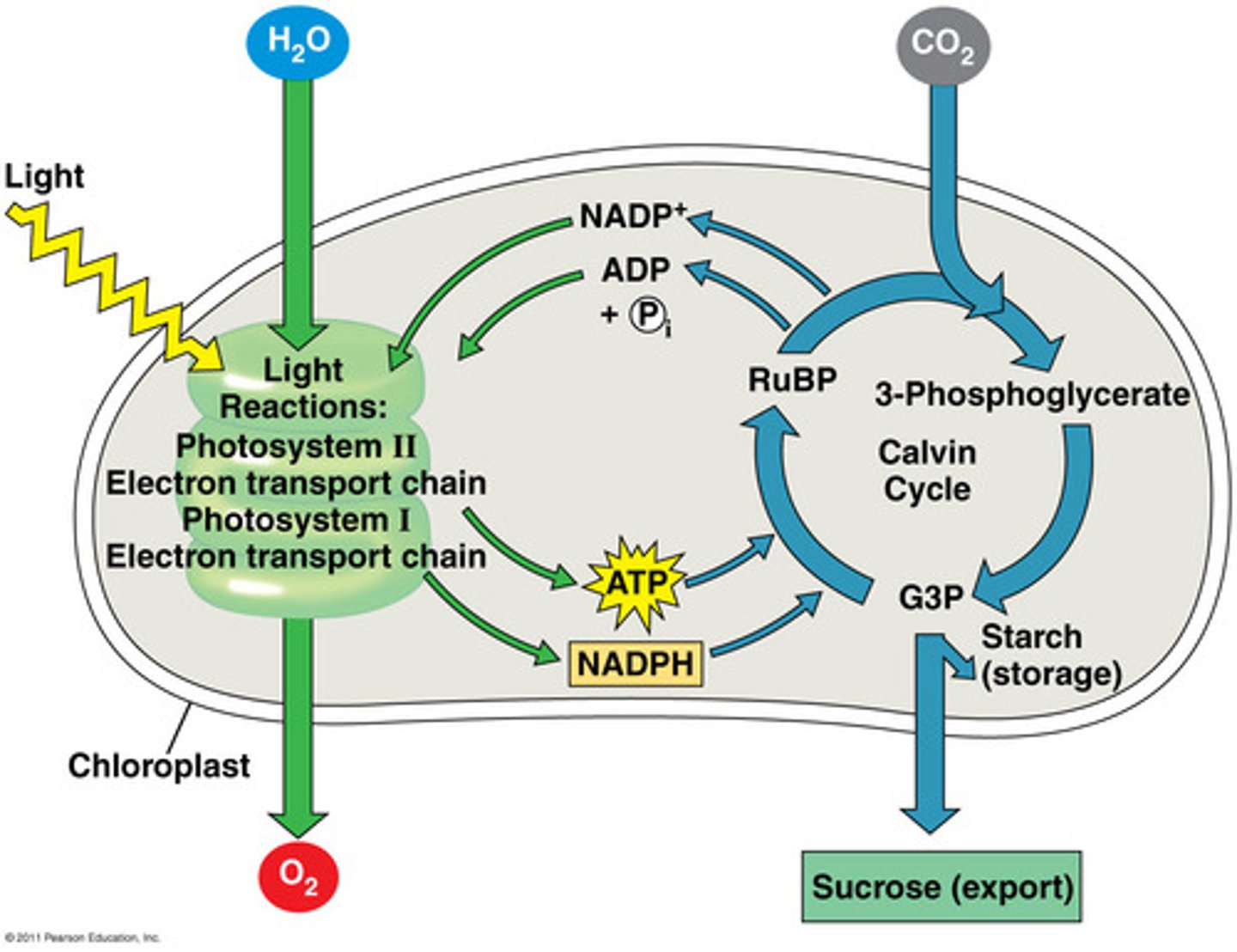
What is carbon fixation?
- CO2 reacts with RuBP forming PGA
- this reaction is catalyzed by an enzyme nicknamed "rubisco" (ribulose bisphosphate carboxylase)
- the amount of CO2 fixed determines how much sugar can be produced
start w/ - 6 RuBP (30 C)
add - 6 CO2 (6 C)
end w/ - 12 PGA (36 C)
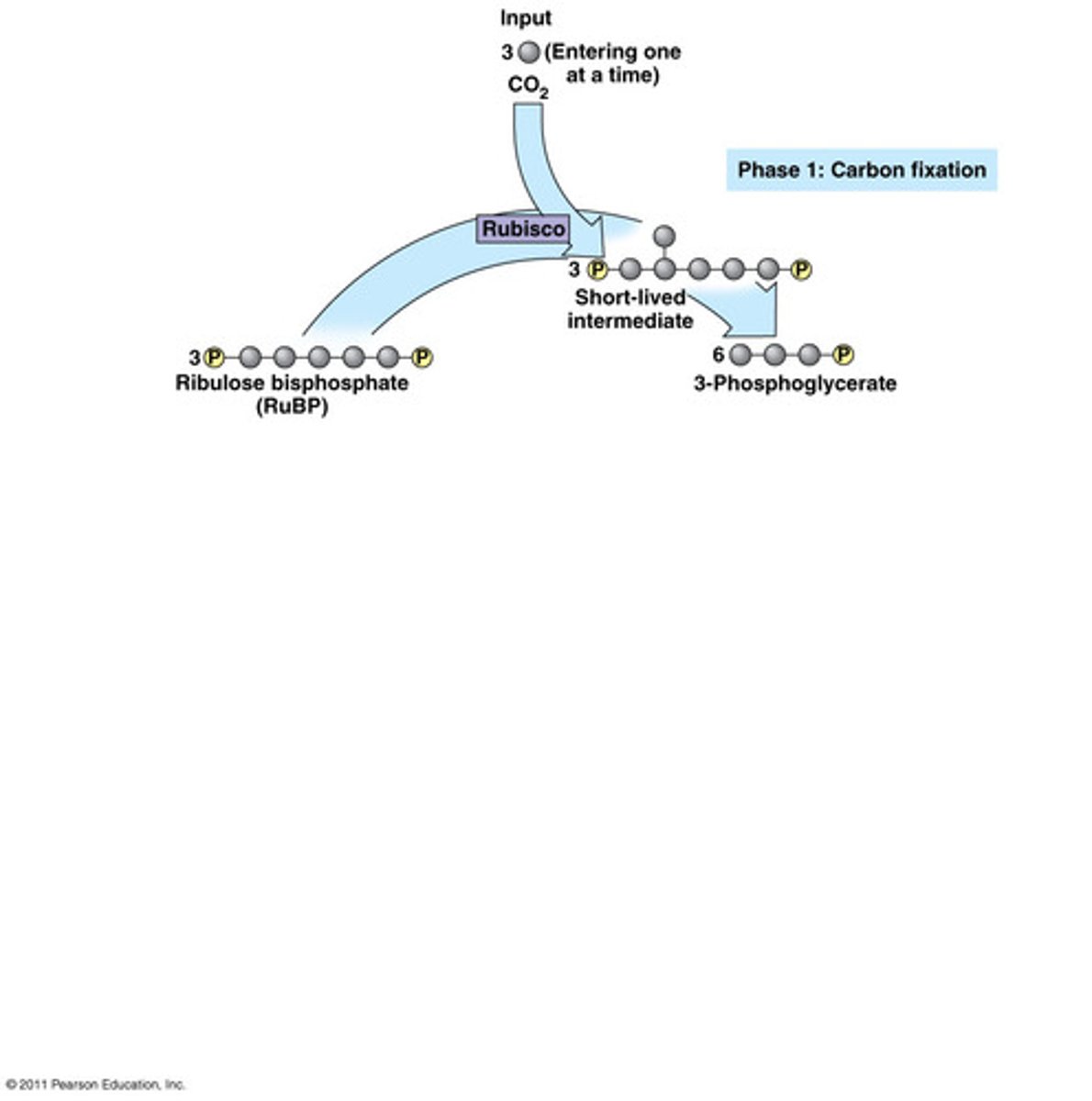
What is reduction in the Calvin cycle?
- energy from ATP & HEe- from NADPH are used to convert PGA into G3P
- at this point, the "extra" G3P can just leave the cycle
- 2 G3P ---> 1 glucose
start w/ - 12 PGA (36 C)
add energy from ATP (leaving ADP + P)
add HEe- from NADPH (leaving NADP+)
ends w/ - 12 G3P (36 C)
by-product = 2 G3P (6 C) leave to make glucose
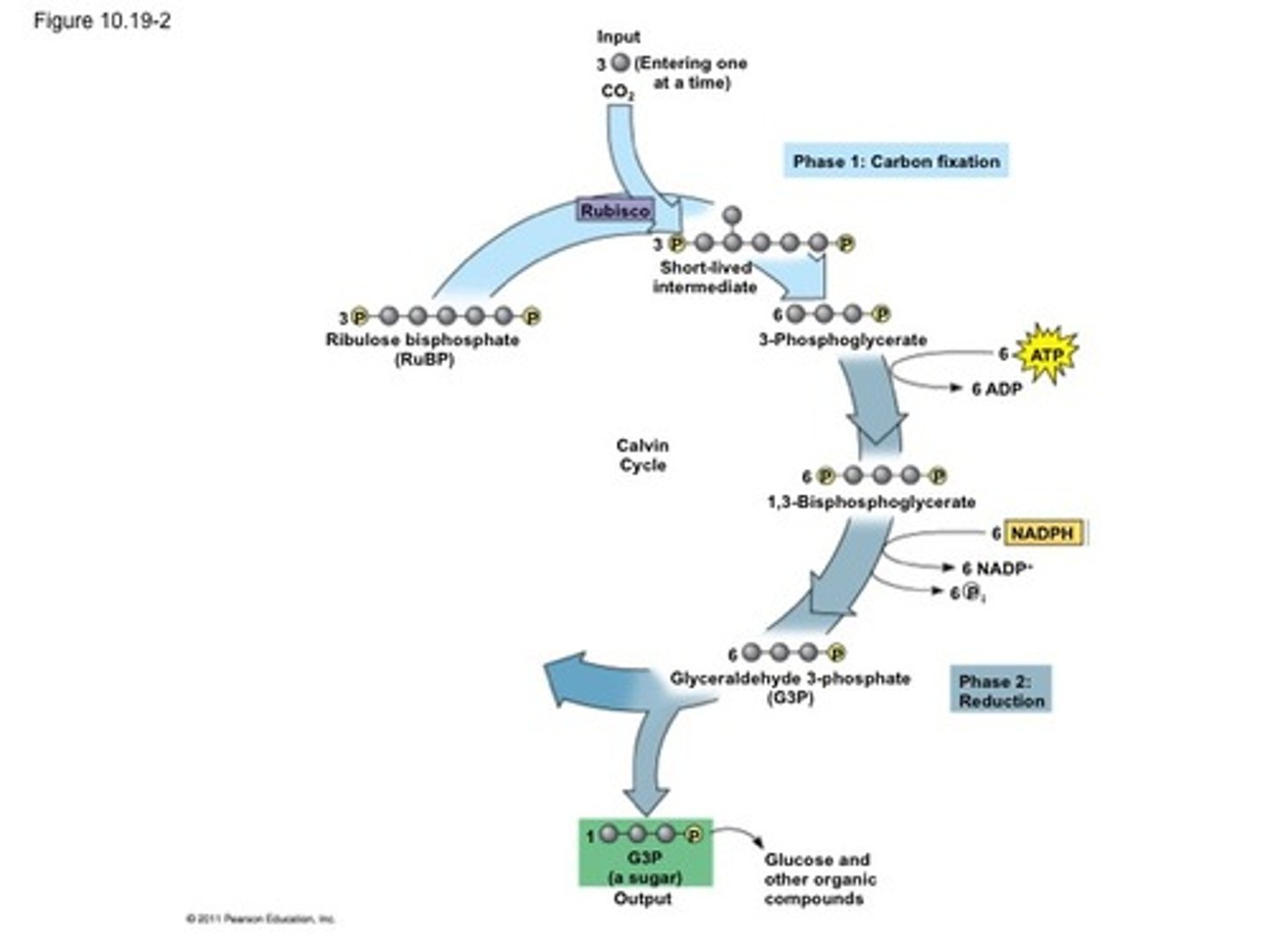
What is regeneration?
- the remaining G3P get converted back into RuBP with the help of ATP
starts w/ - 12 G3P (36 C)
- 10 G3P (30 C) are left to continue in the cycle after the 2 G3P (6 C) left to make glucose
ends w/ "cyclic" molecule - 6 RuBP (30 C)
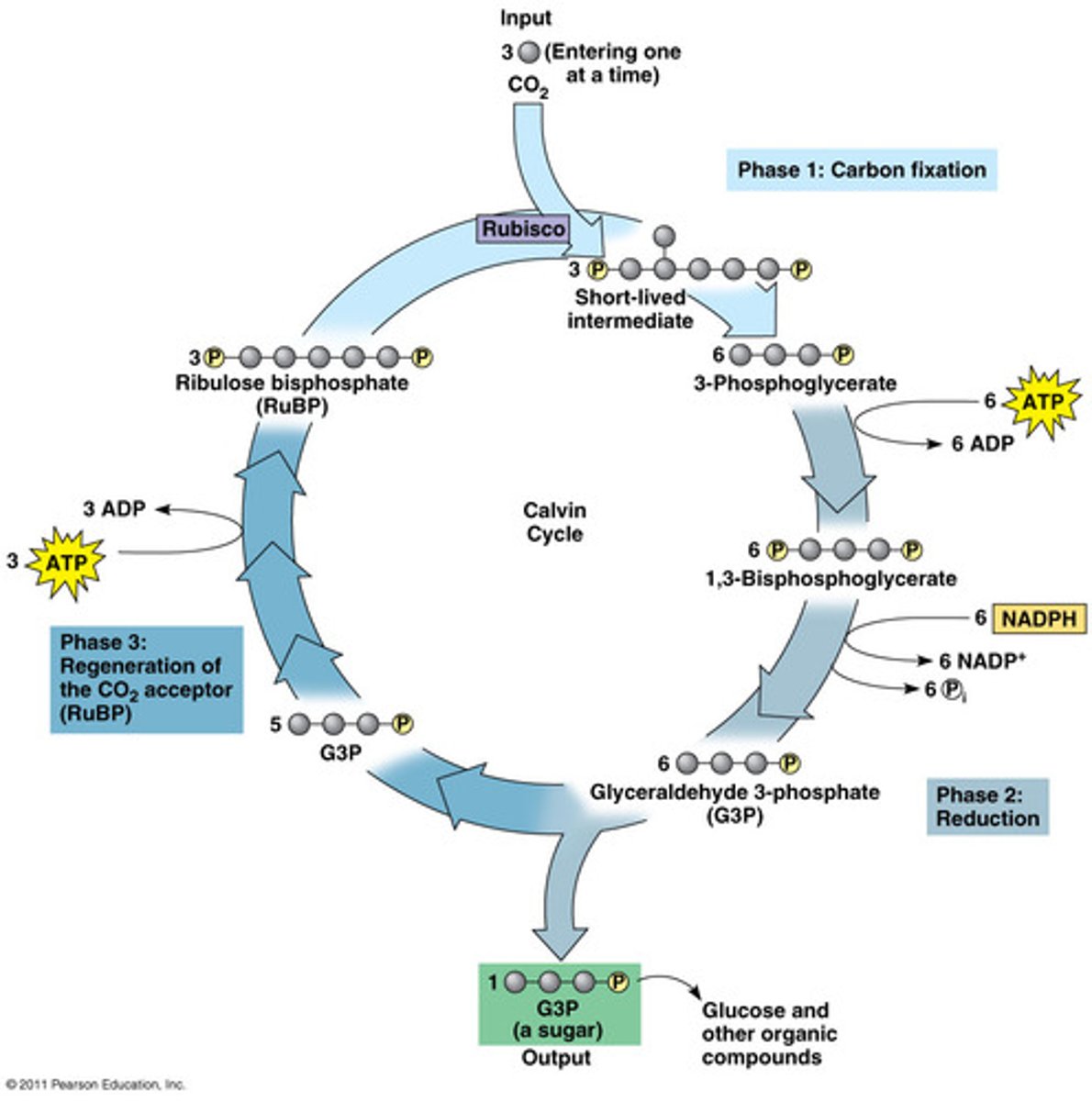
what is energy? what is it measured in? what are its forms?
the ability to do work (causing change)
- not! considered matter
- commonly measured in joules or calories
- 2 forms: potential energy and kinetic energy
What is potential energy? what are its forms?
the stored form
- chemical potential energy: stored in the bonds between atoms in a molecule
- positional potential energy: stored because of the position/location of an object
What is kinetic energy? what are examples/forms?
form in active use
- movement/relocation
- heat
- light and other forms of radiation (UV rays, X-rays, etc.)
- sound
------>>>>>>>>> these forms are typically fueled by the "spending" of potential energy
What is the first law of thermodynamics?
energy in the universe cannot be created or destroyed
- it is conserved
- it. can only change form
- you cannot make energy
- it is expended
What is the second law of thermodynamics? what is entropy?
changes in the form of energy will occur spontaneously (effortlessly) if they increase entropy in the universe
- entropy: measures the degree of disorder in the universe
----->>>> greater disorder implies more stability
- events that decrease entropy/make less stable will:
--->> be non-spontaneous
--->> require energy investment

what is ATP? what is it used for? what is the reaction equation and what is the source of this? does ATP have high or low entropy?
ATP = adenosine triphosphate (3 phosphate groups, ribose, and adenine)
... it's the energy "currency" of cells
- used for most types of cellular work
- formed by the dehydration reaction (removes H2O creating bond)
ADP + phosphate + energy -> ATP
(less stable/least entropy/top of slide bc it can be broken/messed up)
- energy to fuel this reaction can come from various sources:
-->> e.g. energy released when food molecules are broken down during cellular respiration
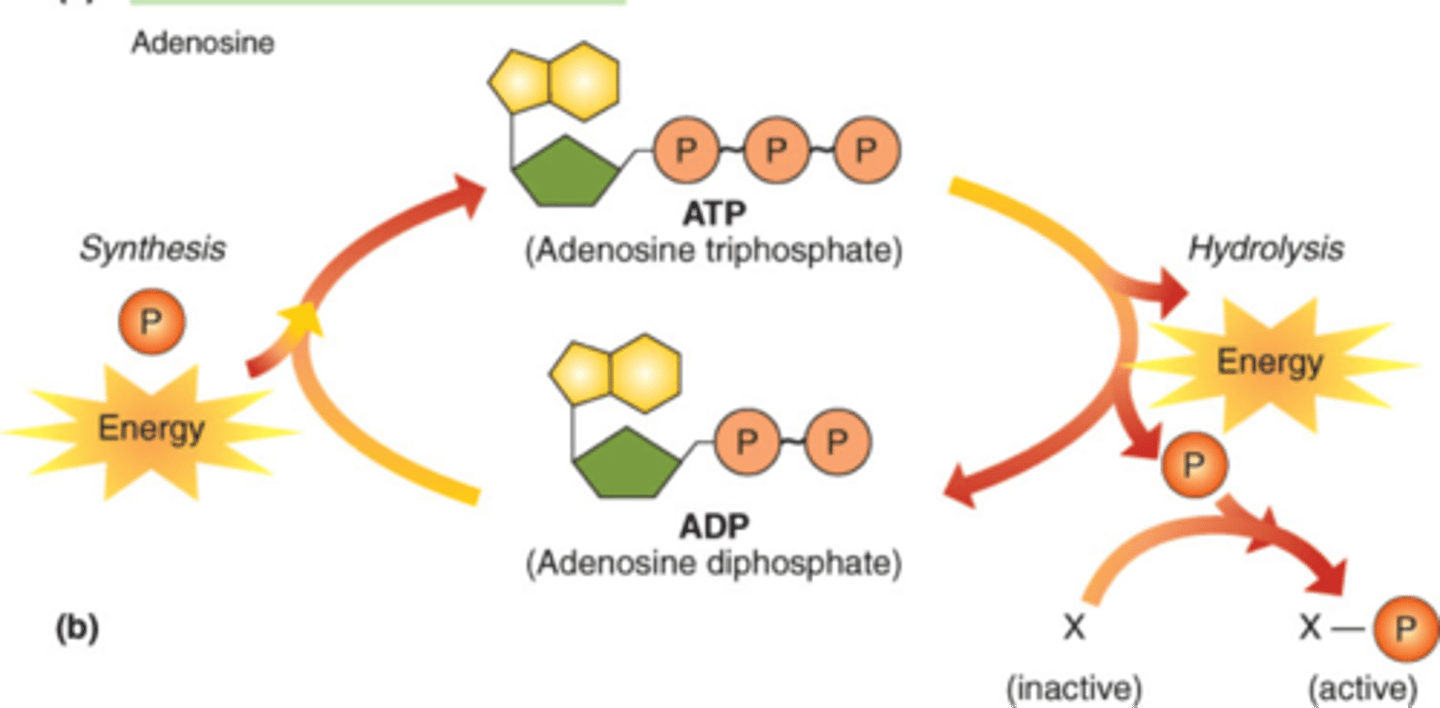
What is ATP energy used for? how is ATP broken down? how does this power cellular work? does this process increase or decrease entropy?
energy is used to create the bond between the 2nd & 3rd phosphates
-> energy is now stored in that bond
ATP energy is spent when the bond between the 2nd and 3rd phosphate is broken in a hydrolysis reaction (water added in to break bond/aka digestion)
->> releases the 3rd phosphate and the stored energy
------>>>>> this is stable/most entropy/bottom of slide because it's already broken/messed up
hence...
ATP -> ADP + phosphate + energy
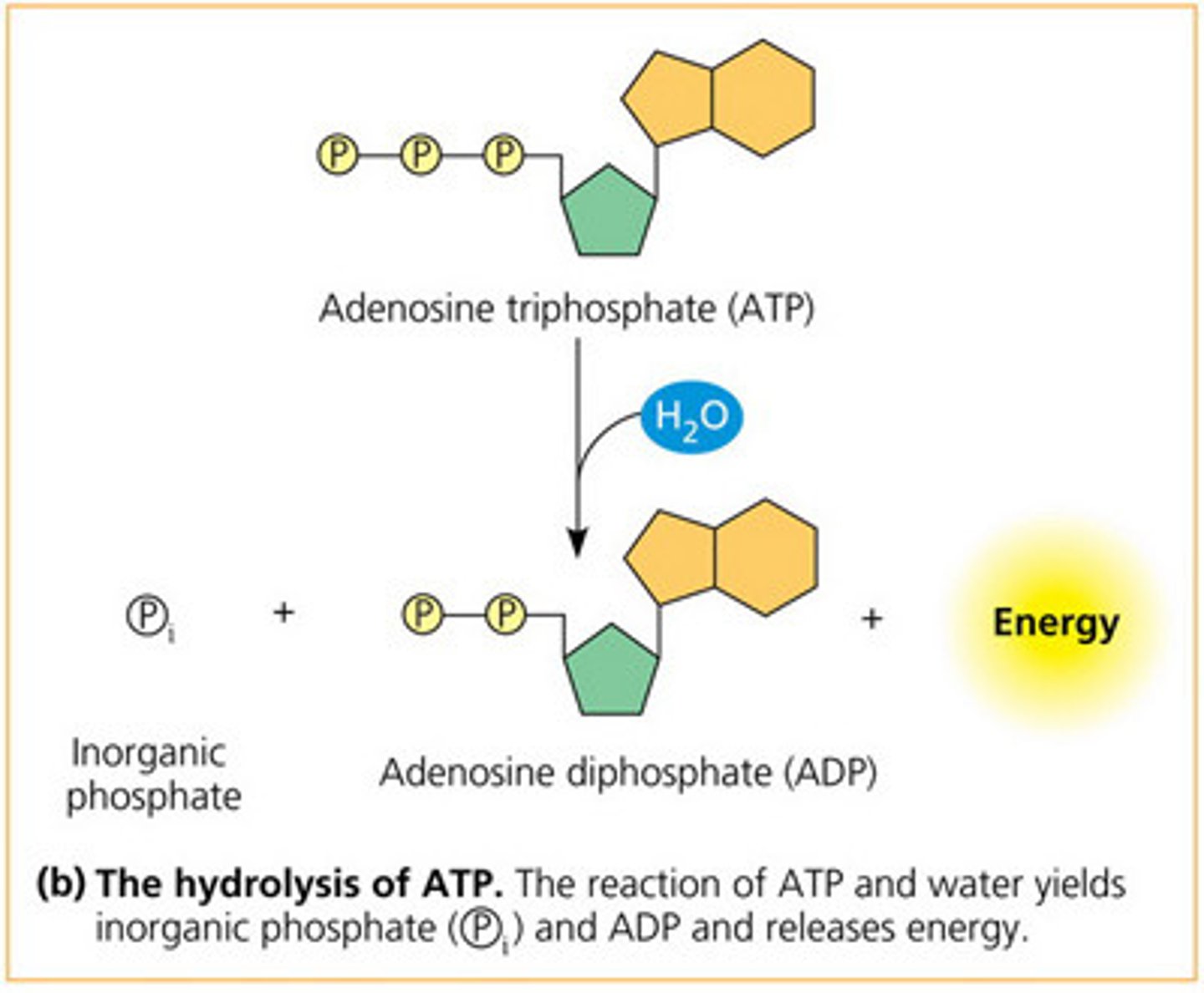
what happens after the third phosphate in ATP is released? what does the phosphate go on to do and what is this called? what is the result after its job is done?
this 3rd phosphate can hold on to the energy released from that bond
(the phosphate and the energy "stick" together when the bond is broken, via hydrolysis, releasing energy and when the phosphate leaves the phosphate holds onto that released energy)
--->> the phosphate is released as a "high energy phosphate" (HEP)
- the transfer of this HEP to another molecule = phosphorylation
-->> can energize an otherwise inactive molecule, providing fuel to accomplish a task/do work
- energy from this HEP is spent on some form of cellular work and the result is a "low energy phosphate" (LEP)
->> this LEP detaches from the phosphorylated molecule
-----> returns the molecule to its original (inactive) form
-----> the released LEP is then "loose" in the cell
(this hot potato analogy)
what are the three types of cellular work?
chemical, mechanical, and transport
what is chemical work?
energy invested to form bonds between atoms during chemical reactions (makes or breaks chemical bonds)
-->> the energy then stored in those bonds
what is transport work?
energy invested to force materials to move across membranes
-->> the energy is then stored in the position of those materials
what is mechanical work?
energy invested to move cell parts relative to one another
-->> that energy may be either totally spent in the movement itself
what is metabolism?
sum of all chemical reactions
what is catabolism?
(catastrophe)
- breaks bonds
- releases energy
- exothermic (negative change in energy; energy was there and now its not: it went somewhere else)
- increases entropy (goes down the slide)
- spontaneous
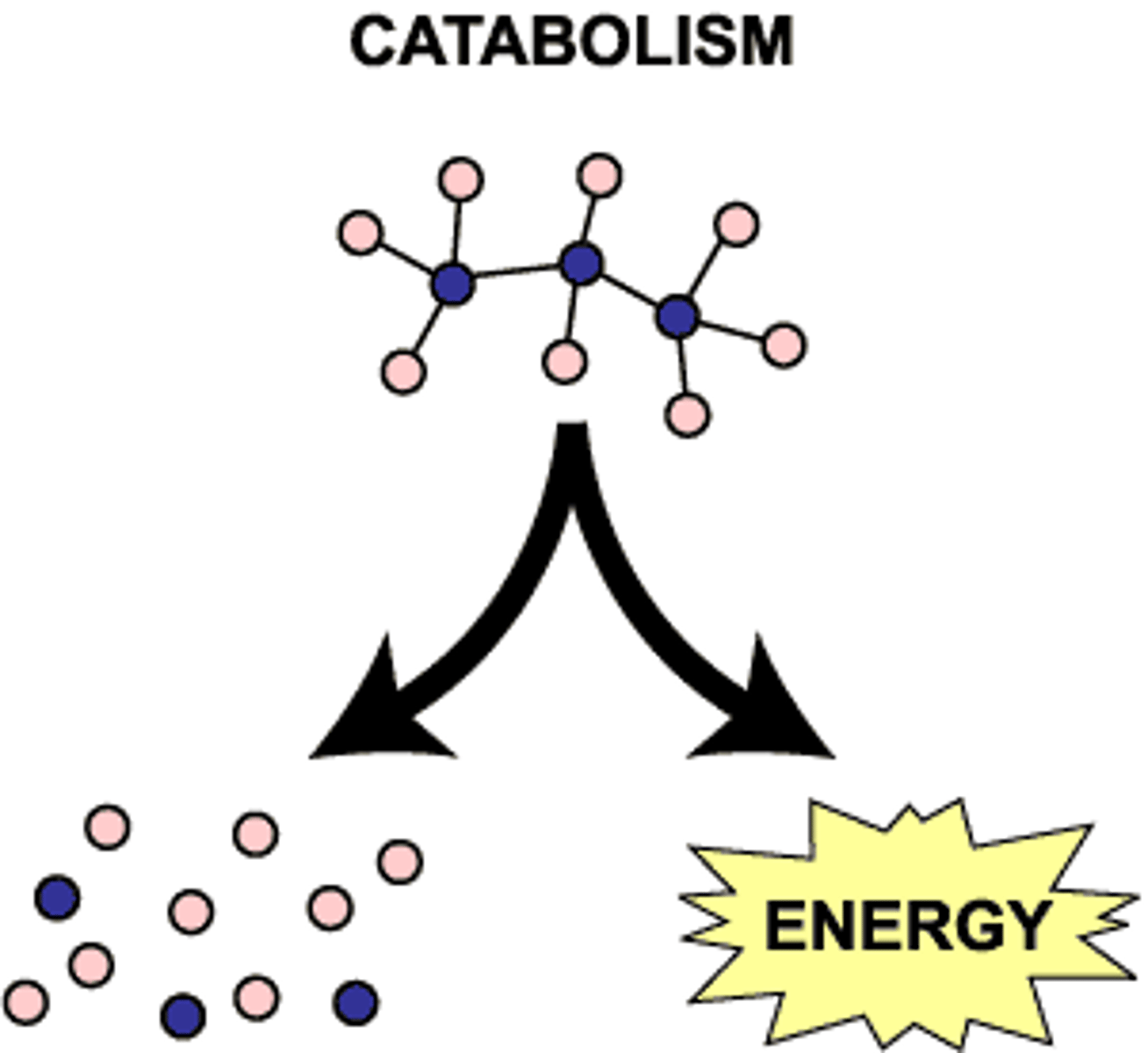
What is anabolism?
(assembly)
- makes bonds
- requires energy
- endothermic (positive change in energy)
- decreases entropy (up the slide)
- non-spontaneous
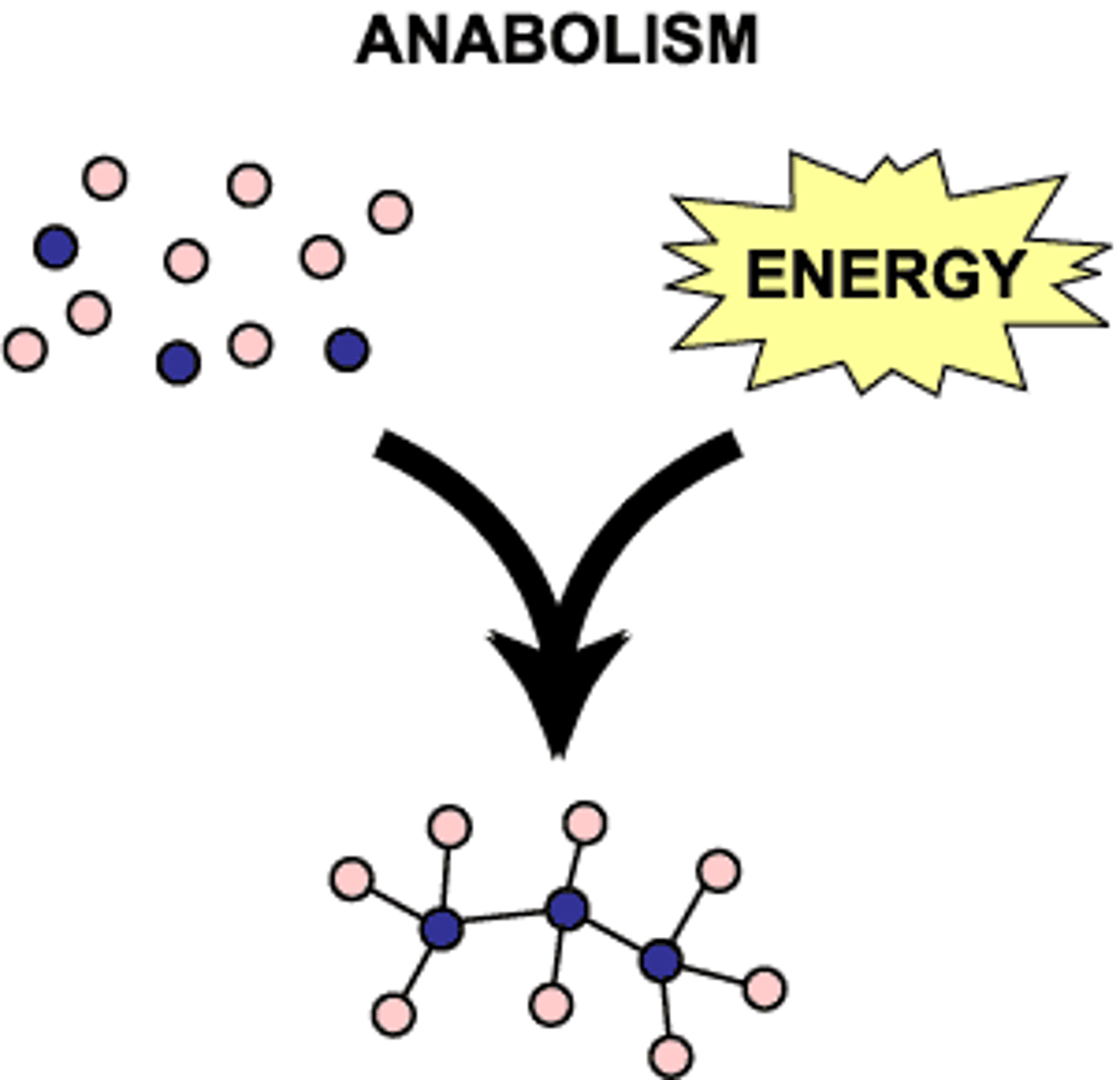
What are exothermic reactions?
energy is released/negative change in energy

What are endothermic reactions?
requires energy/positive change in energy
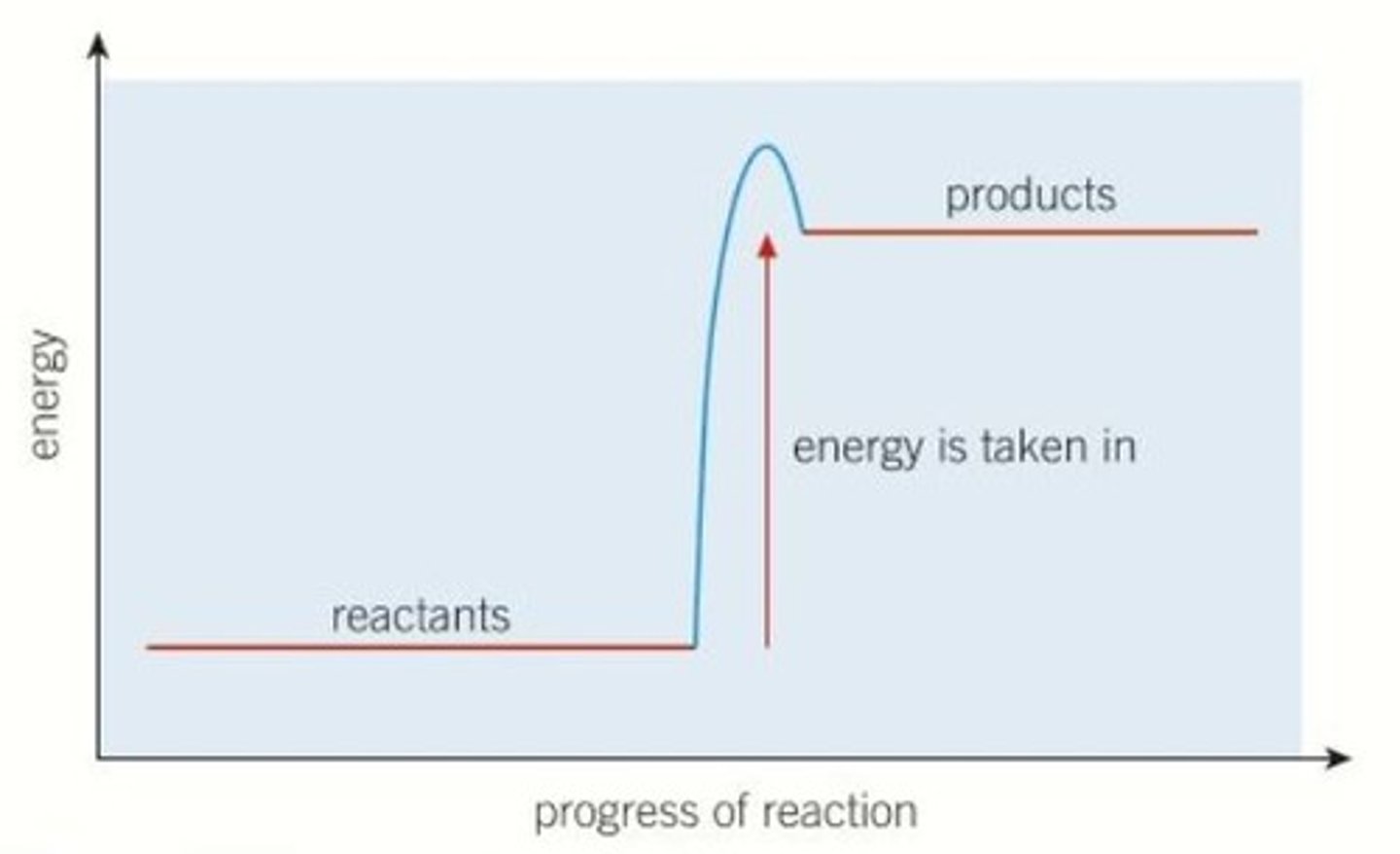
how are exothermic and endothermic reactions related?
they power each other (hence, energy coupling)
What is energy coupling? (metabolism "couples" events)
energy coupling:
- spontaneous events is "coupled" non-spontaneous ones
- the energy released by one provides the fuel for the other
--->> hydrolysis of ATP + chemical work
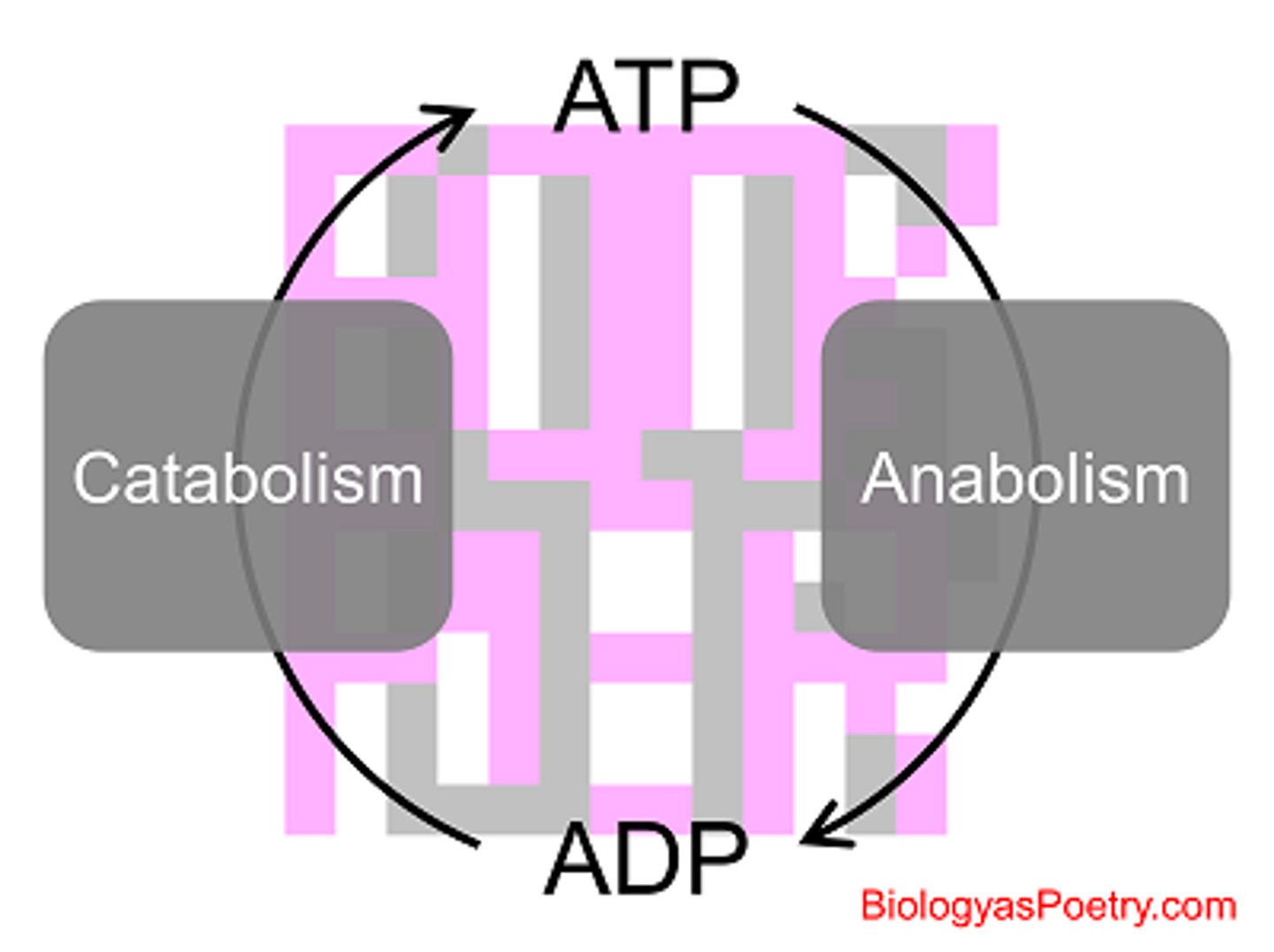
How does activation energy work? what is it?
- there is an "energy hurdle" to get all chemical reactions started
- reactions only react once they have reached a "transition state"
--->> activation energy = the energy required to get reactions started
- causes instability in the bonds of reactions to reach a transition state
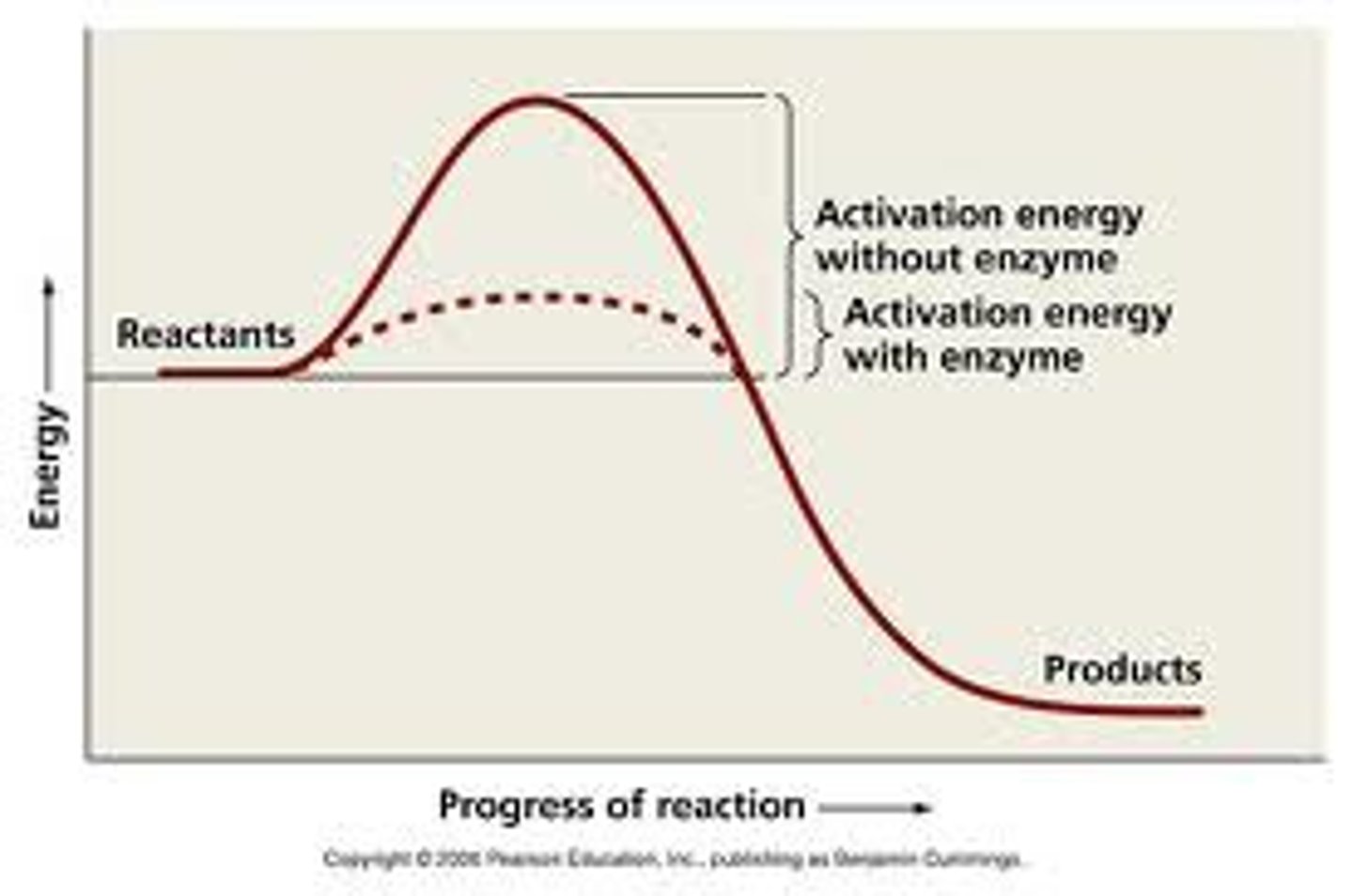
what can provide activation energy?
- heat can provide activation energy
-->> causes reactants to slam into each other - triggering instability
-->> can disrupt homeostasis and cause biomolecules to denature (loose their function)
What are catalysts? what are enzymes? how do they affect activation energy?
catalysts = substances used to aid chemical reactions with the activation energy hurdle
--> enzymes = biological catalysts / proteins that facilitate chemical reactions
- reduce the amount of activation energy required by helping trigger the transition state
- speeds up reaction rate:
-->> # reactions / unit time
-->> not damaged by reactions (can be re-used)
-->> do not provide activation energy
-->> cannot make endothermic (positive change in energy) reactions occur

what is a substrate? how does a substrate and enzyme interact?
enzymes work exclusively with certain reactant molecules known as substrates; enzymes are "substrate specific"
- interact with substrate(s) at its active site
-->> which is compatible with substrate(s) in terms of:
size, shape, and chemical nature (polar, nonpolar, + or -)
- when enzyme and substrate bind it creates the "enzyme-substrate complex"
- causes the enzyme to experience a subtle change in shape known as induced fit
-->> induced fit applies stress to the substrate(s) (helping to trigger the transition state and making the reaction easier to get started)
-->> the reaction itself converts any substrates/reactants to products
-->> enzymes then release the products, return to their original shape, and can bind new substrate(s)
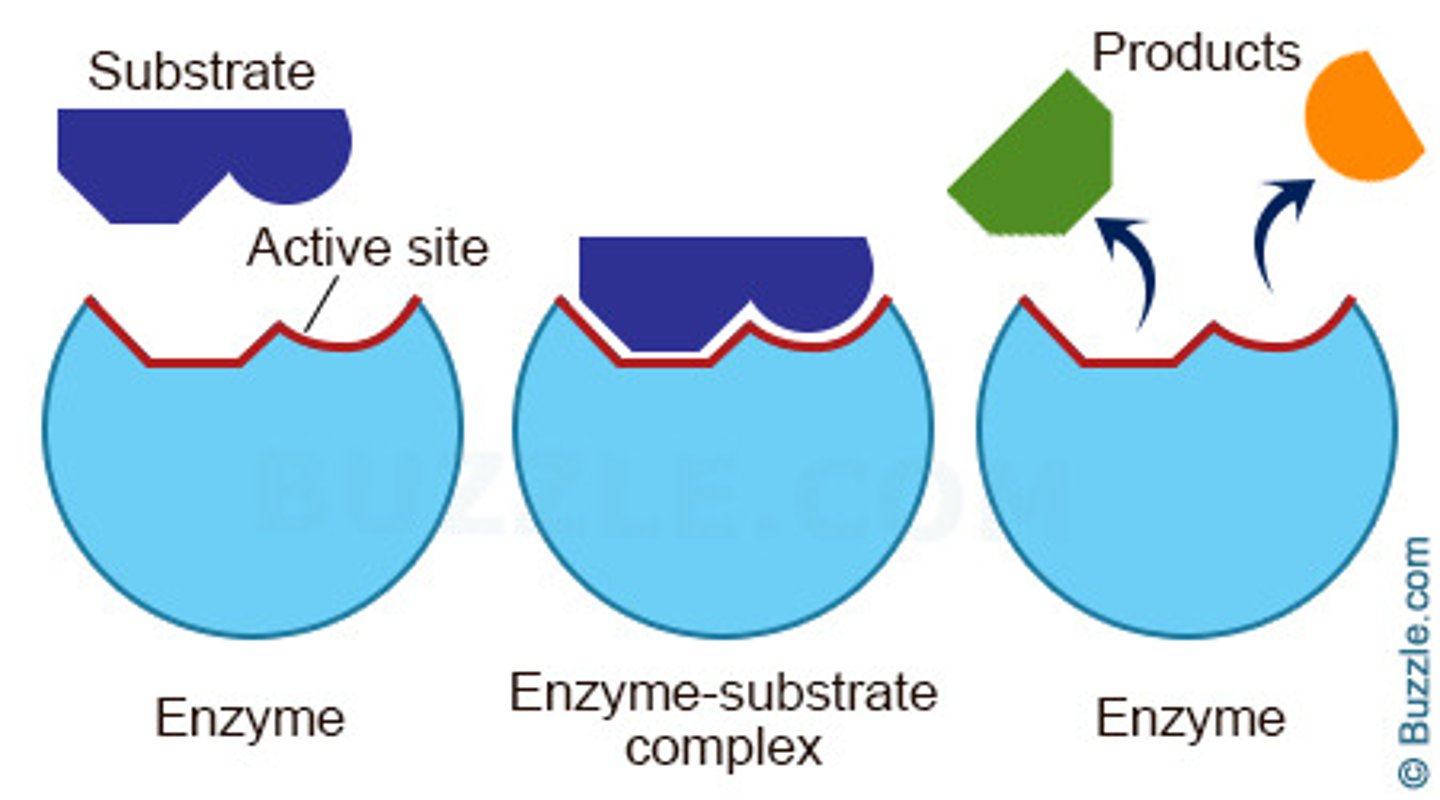
what is a metabolic / biochemical pathway?
a series of chemical reaction "steps"
- converts some original molecule to various "intermediates", and eventually to some final product
- requires a different enzyme for each reaction
- these pathways comprise all cellular metabolism

What is enzyme regulation activity influenced by?
enzyme activity is influenced by:
- heat
- pH
- salt concentration
(can cause enzymes to denature; loss of function)
- temporary binding of regular molecules
-->> inhibitors: decrease activity
-->> activators: increase activity

What are activators?
presence increases enzyme activity
- ex: phosphorylation
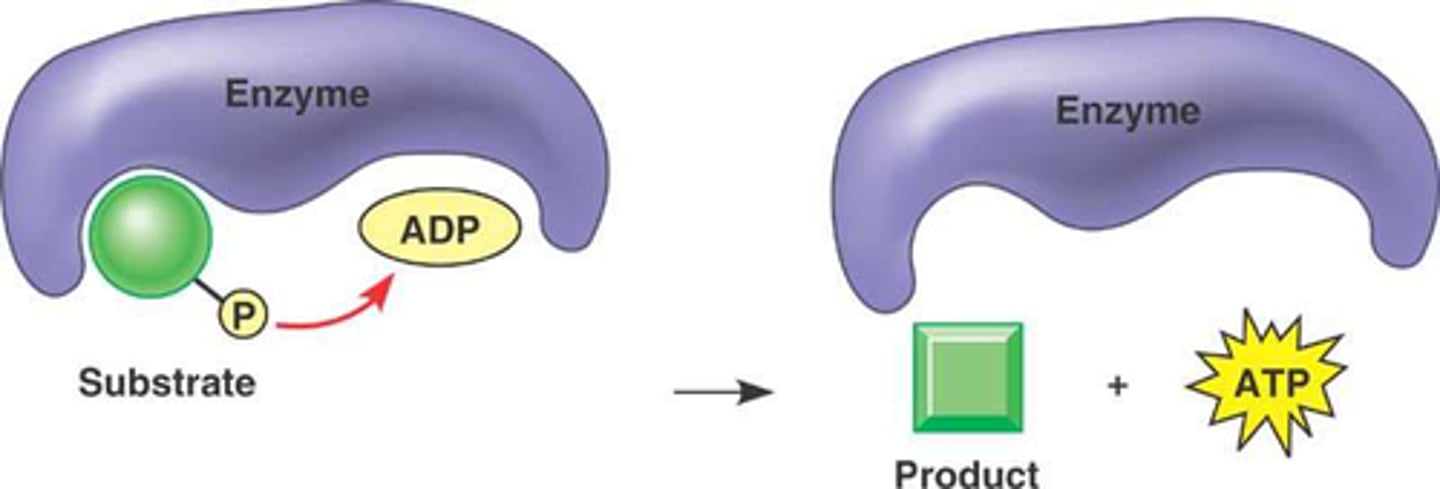
what are the two types of inhibitors?
competitive inhibitors:
- substrate imposters
- bind to active site -> block substrate
(all temporary! enzymes will return to their regular shape)
noncompetitive inhibitors:
- bind to another part of the enzyme
-> shape change - alters active site so substrates cannot bind
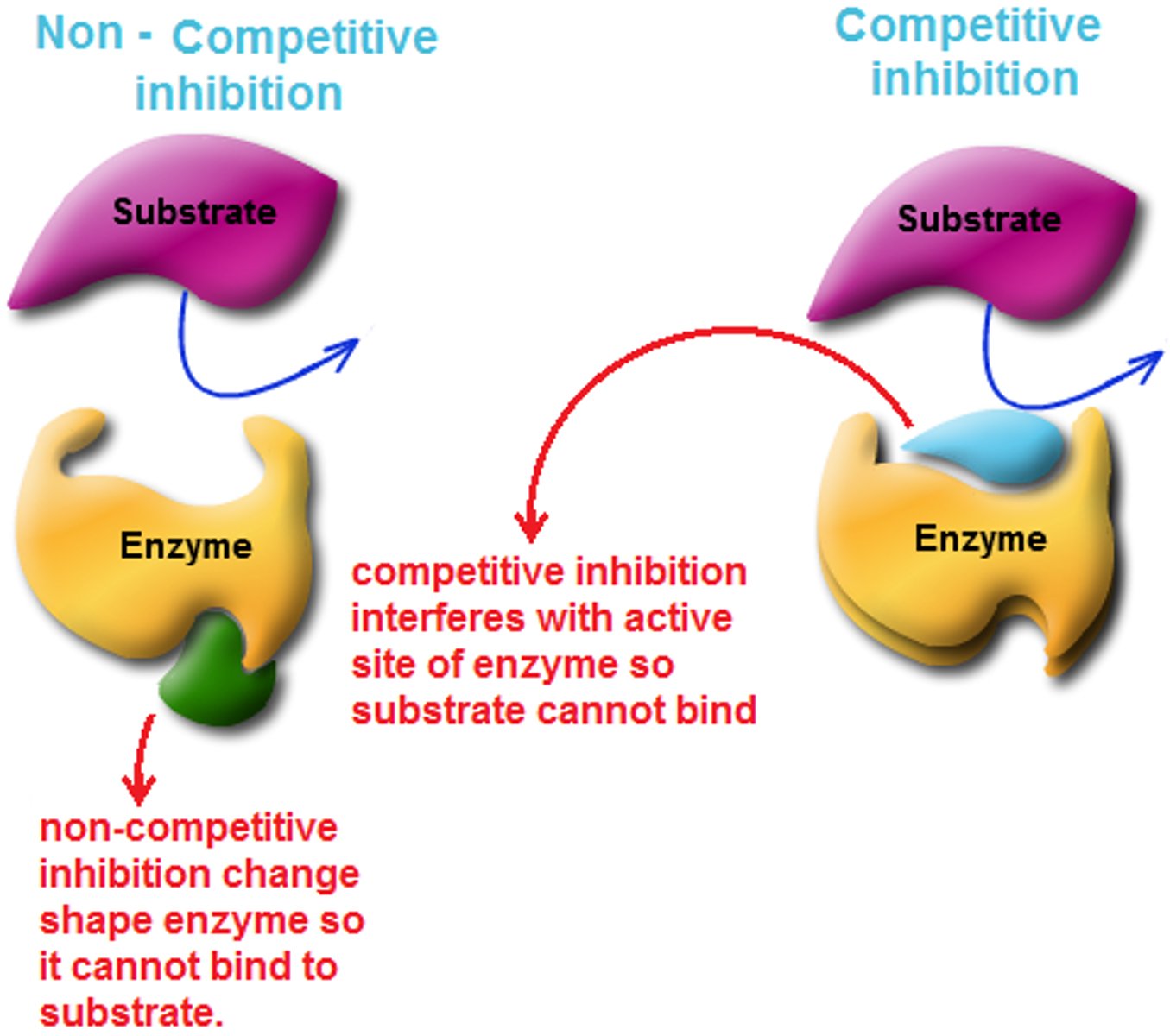
What is selective permeability of transport across membranes?
- membranes only allow chemically compatible materials to cross the phospholipid bilayer
- membranes are only permeable to:
-> nonpolar molecules (O2, lipids, etc)
-> extremely tiny polar molecules (H2O & CO2)
- membranes are not permeable to:
-> larger polar molecules
-> ions of any kind
-->> (these materials require help from transport proteins to cross)
however ability to cross a membrane does not imply interest in doing so!
what is a gradient?
some physical difference between two areas; top of slide vs. bottom of slide (ex: solute concentration)
- is inherently unstable
- stores potential energy (in solute position)
- provides the motivation for substances to cross membranes
--->>> but movement is only possible if the membrane is permeable

what is diffusion? what does it result in?
spontaneous movement of substances to eliminate a gradient
- substances flow from: [high] to [low] "down or with their gradient"
- releases the potential energy
- results in a state of equilibrium = equal distribution of materials across a membrane
![<p>spontaneous movement of substances to eliminate a gradient</p><p>- substances flow from: [high] to [low] "down or with their gradient"</p><p>- releases the potential energy</p><p>- results in a state of equilibrium = equal distribution of materials across a membrane</p>](https://knowt-user-attachments.s3.amazonaws.com/341e6e16-dd5d-484d-b2f2-8259896b18ef.png)
What is passive transport? what are the different types?
- spontaneous movement across membranes
- increases entropy/stability
- possible because of the potential energy stored in a gradient ("gradient driven") - requires no expenditure of cellular energy
- results in equilibrium
3 types:
- simple diffusion
- facilitated diffusion
- osmosis
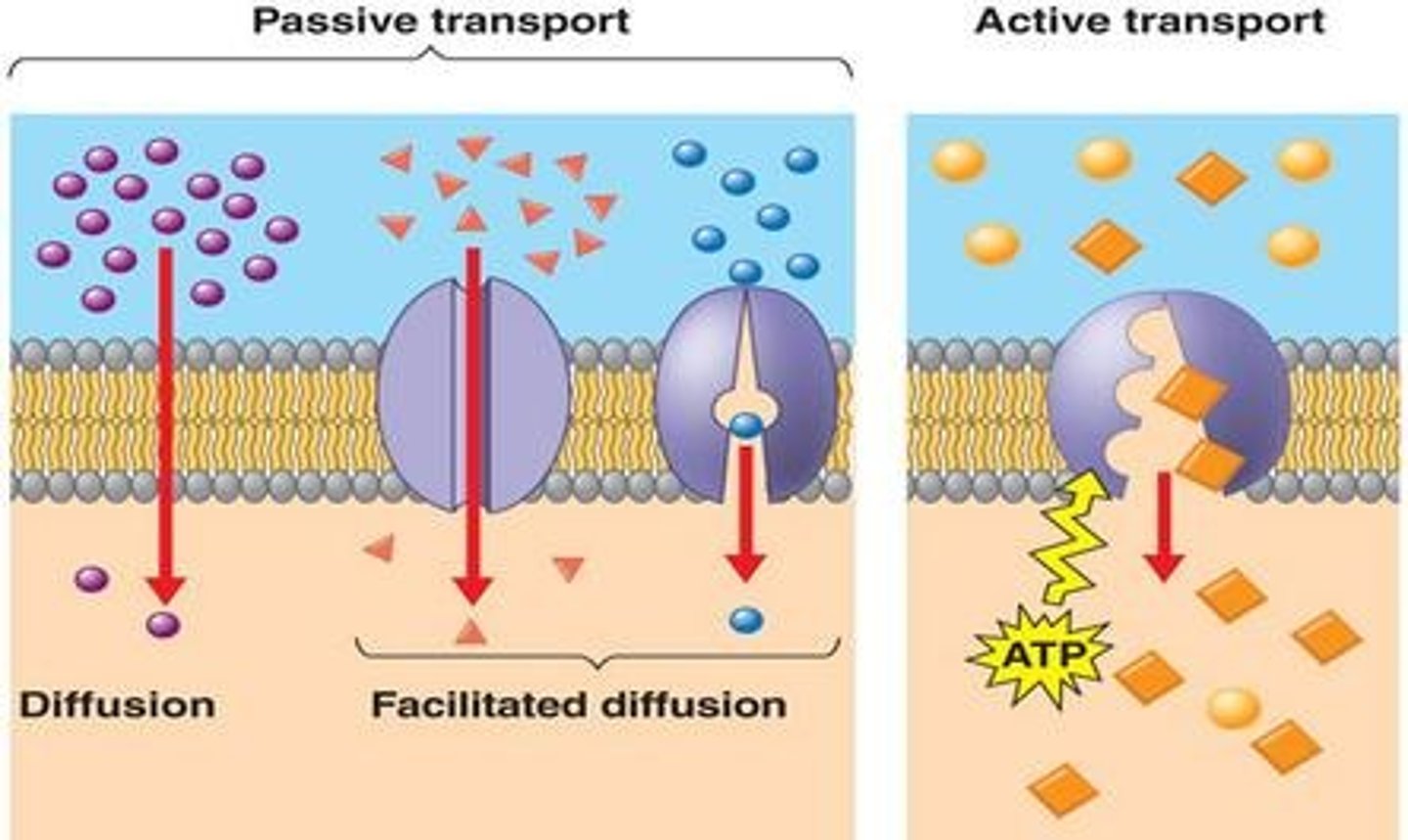
What is simple diffusion?
(H2O, CO2, and lipids)
- solutes move directly through the phospholipid bilayer
- requires compatibility with the "tails"
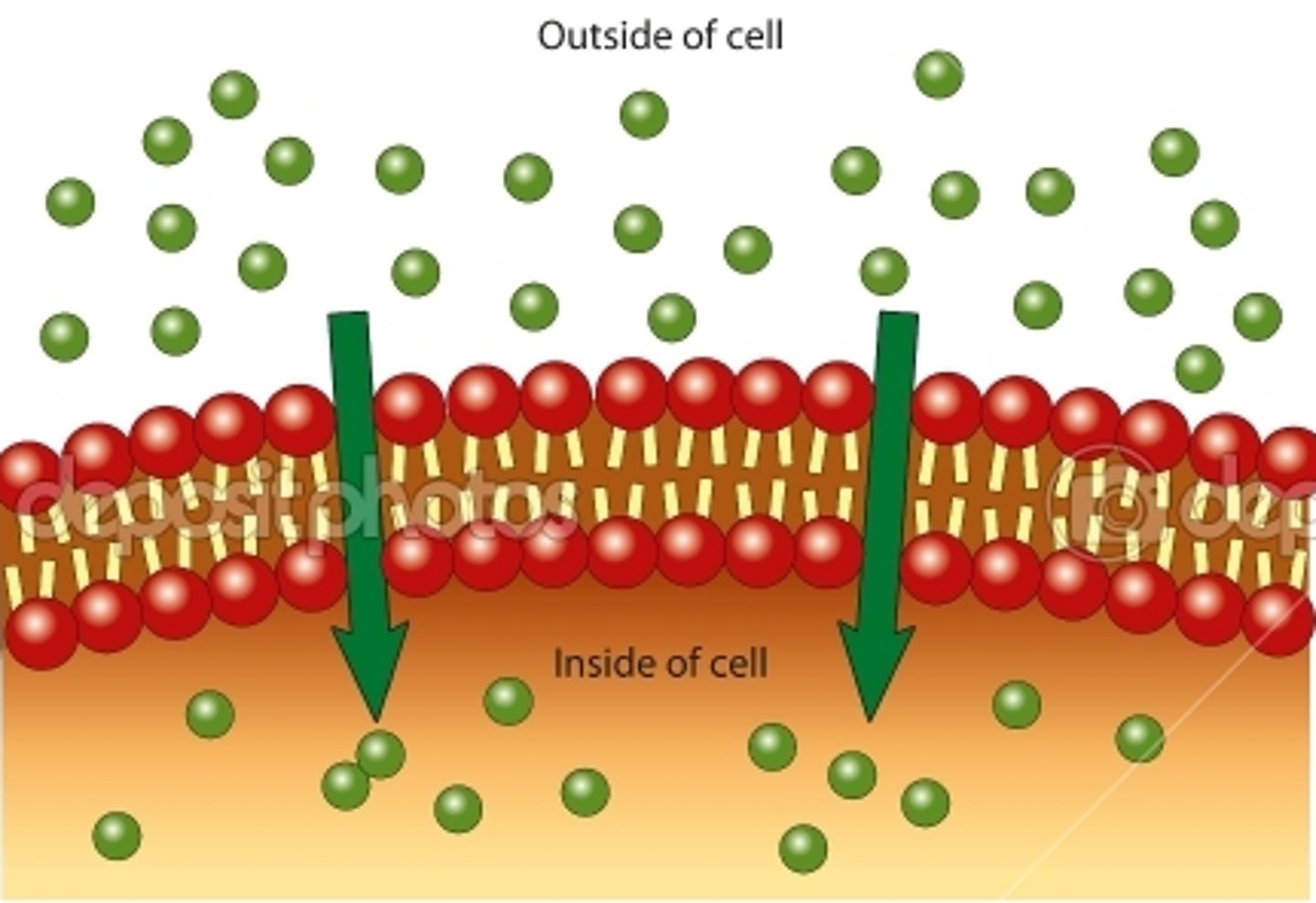
What is facilitated diffusion?
- polar and ionic solutes move across through selective transport proteins
-->> channels or carriers
- requires a cell to both have a gene for the transport protein and have been triggered to express it
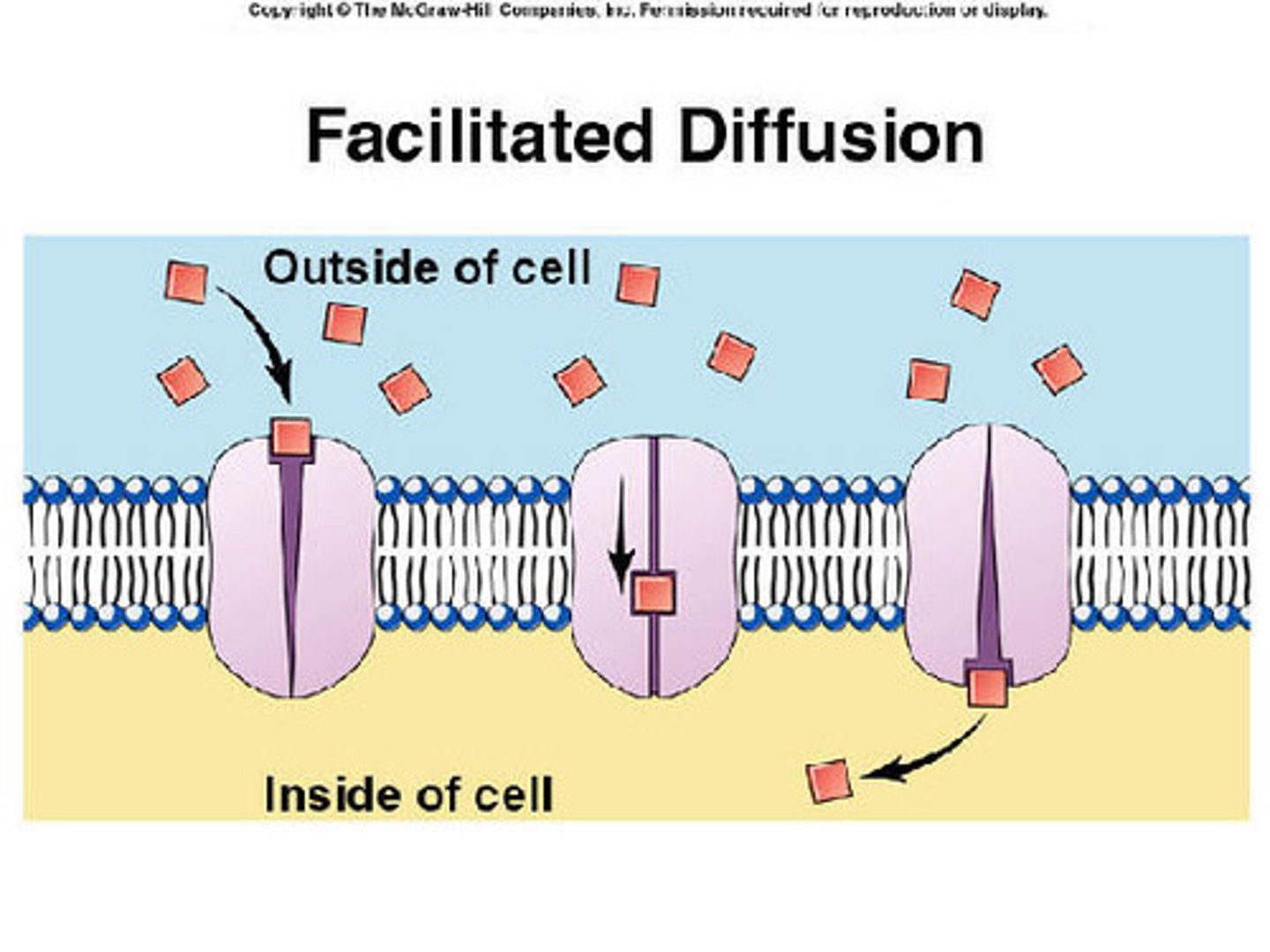
what is osmosis?
- diffusion of H2O down/with its own gradient
- occurs if there is a solute gradient but the membrane isn't permeable and there is no transport protein so the solute is "stuck"
- H2O moves to eliminate the gradient and achieve equilibrium
- solutions are described based on their relative concentrations:
-->> hypertonic = higher concentration
-->> isotonic = equal concentration (equilibrium)
-->> hypotonic = lower concentration
Trend: H2O tends to flow from hypotonic solutions to hypertonic solutions
What will an animal cell do in a hypotonic solution?
lysing / burst
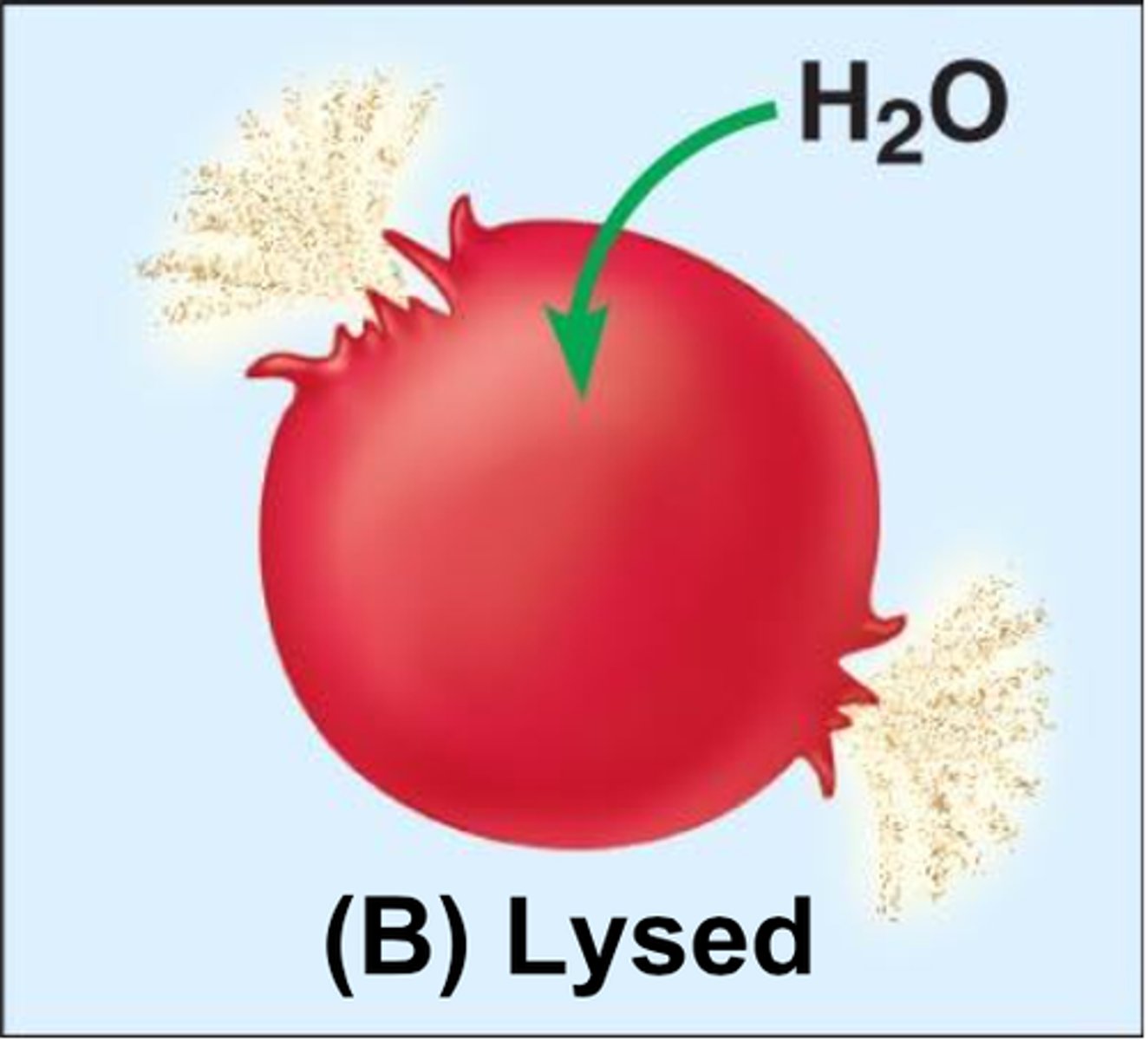
What will an animal cell do in a hypertonic solution?
shrivel / shrink
